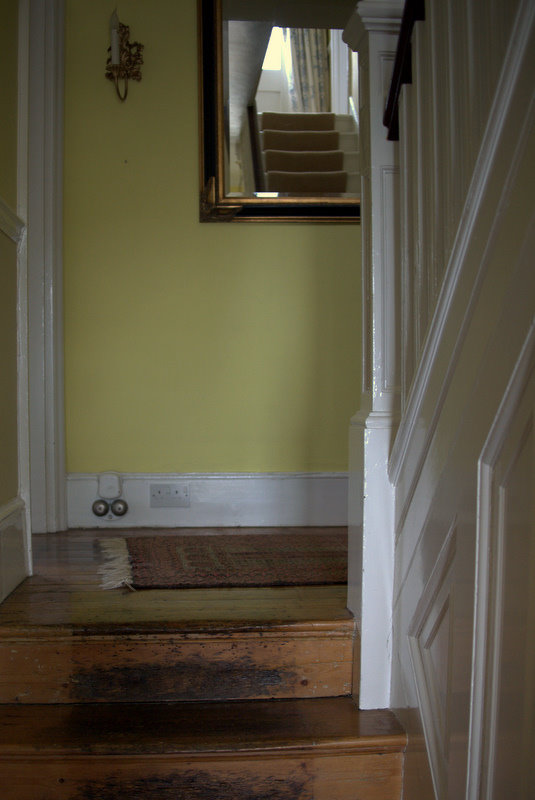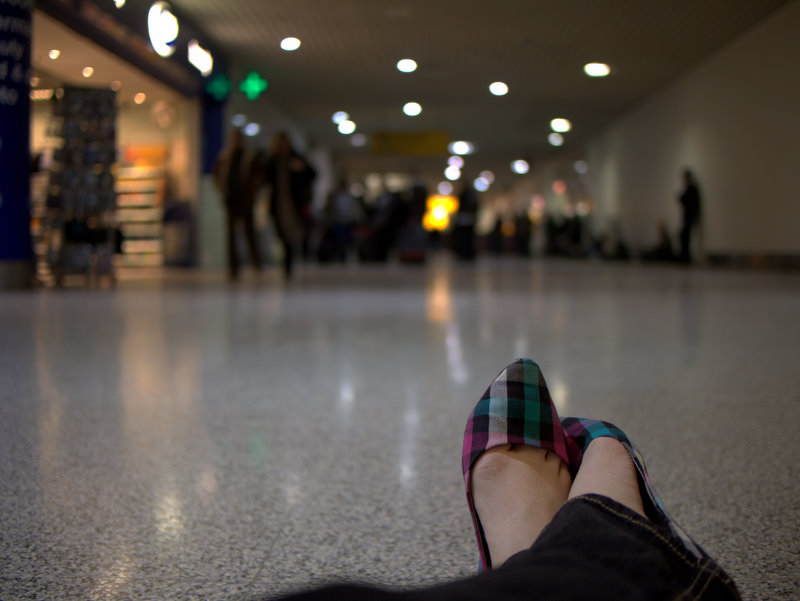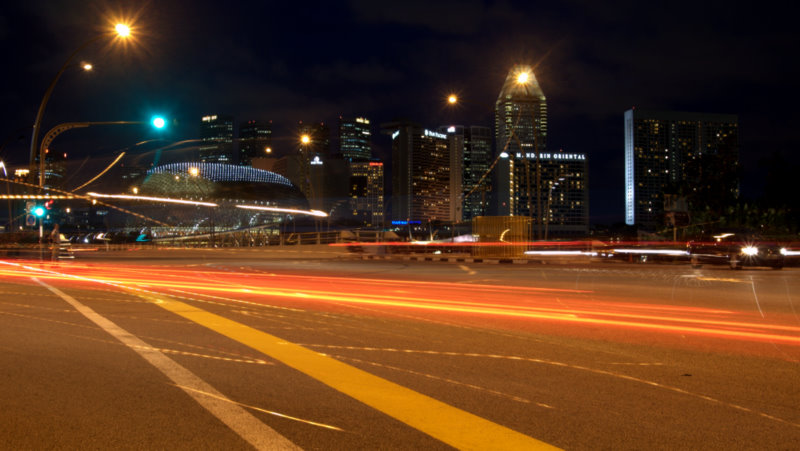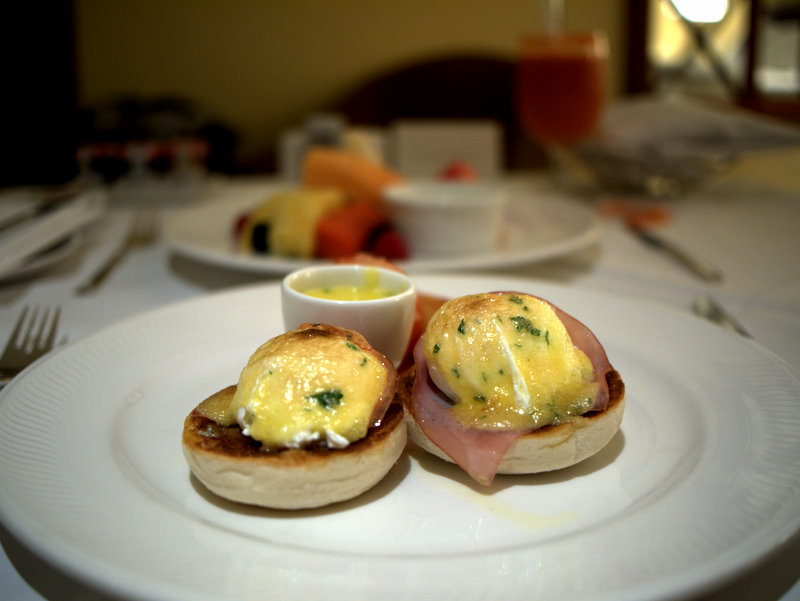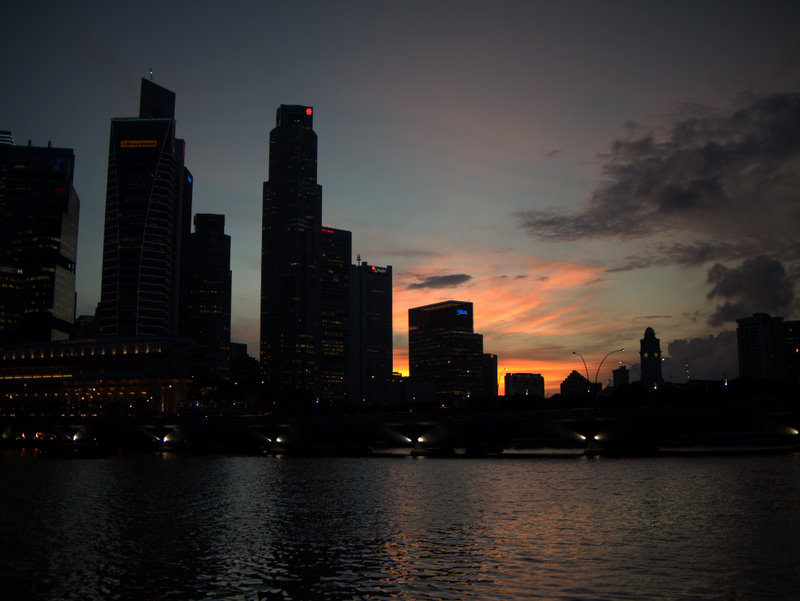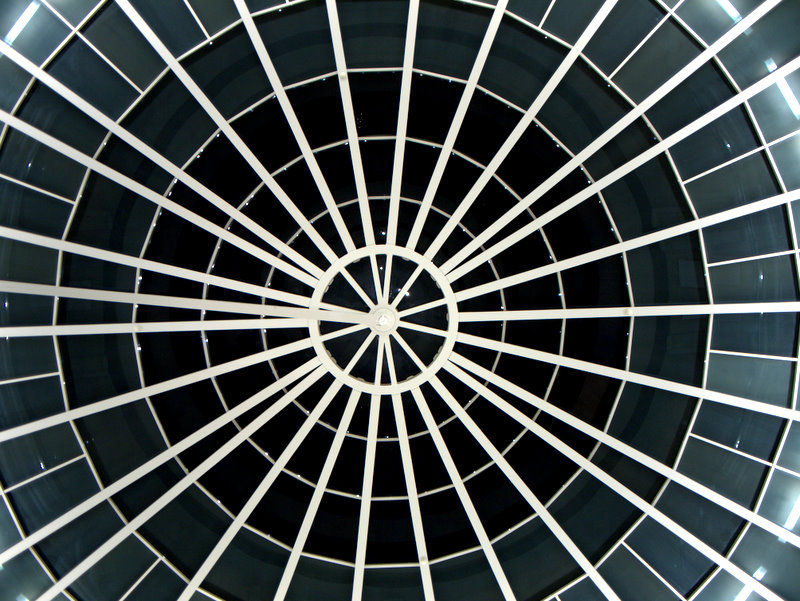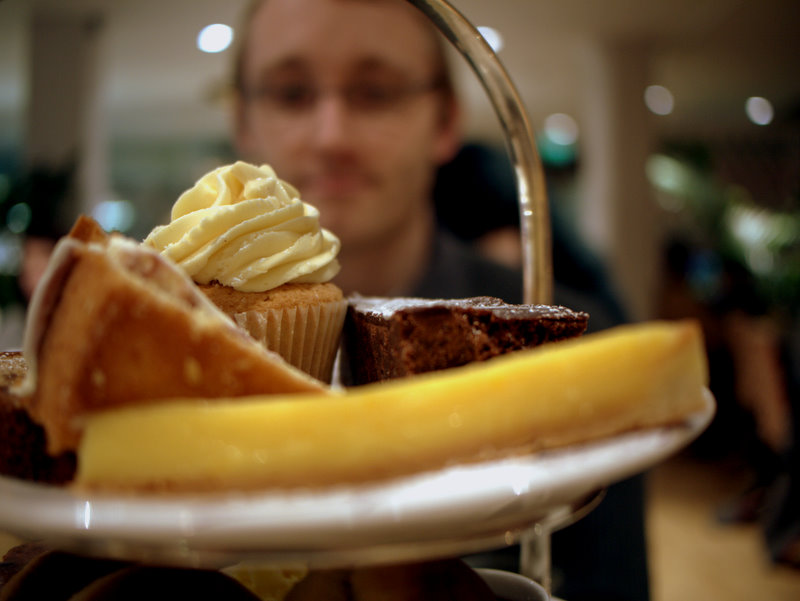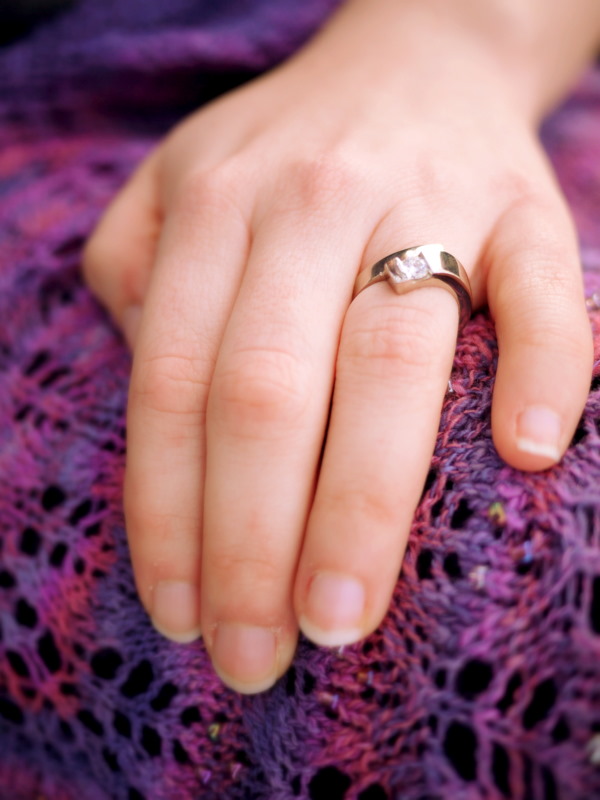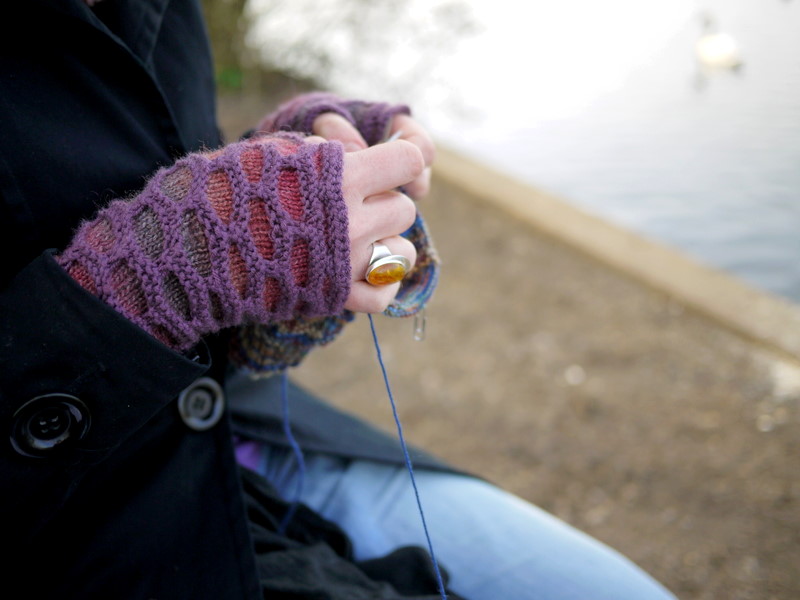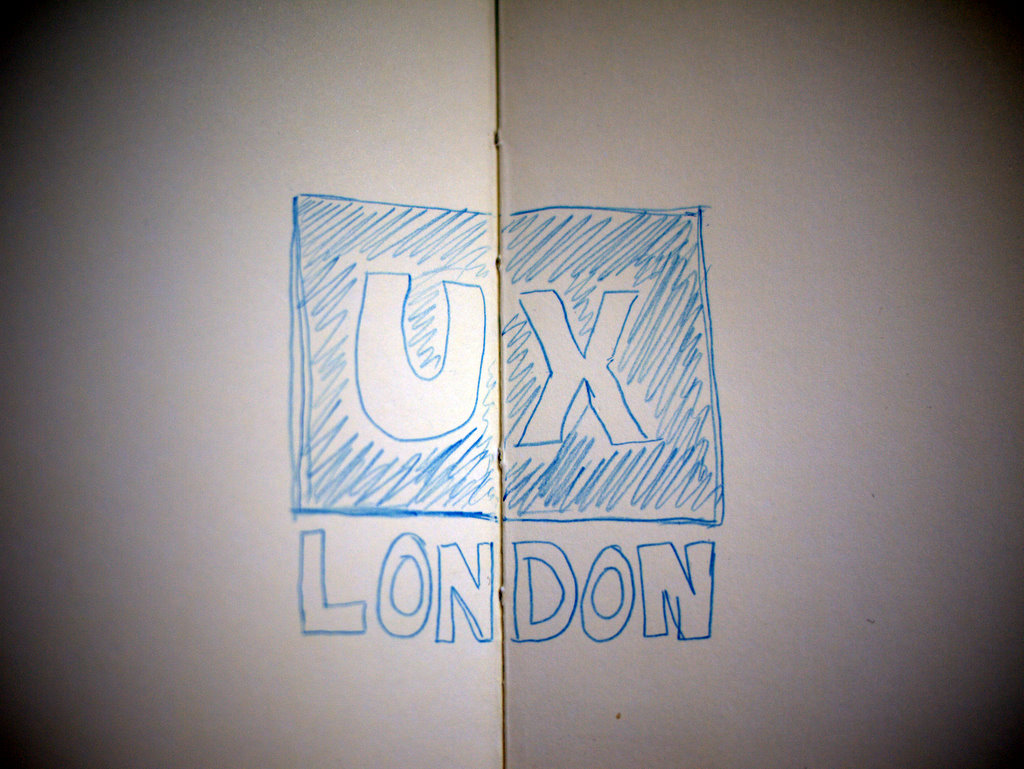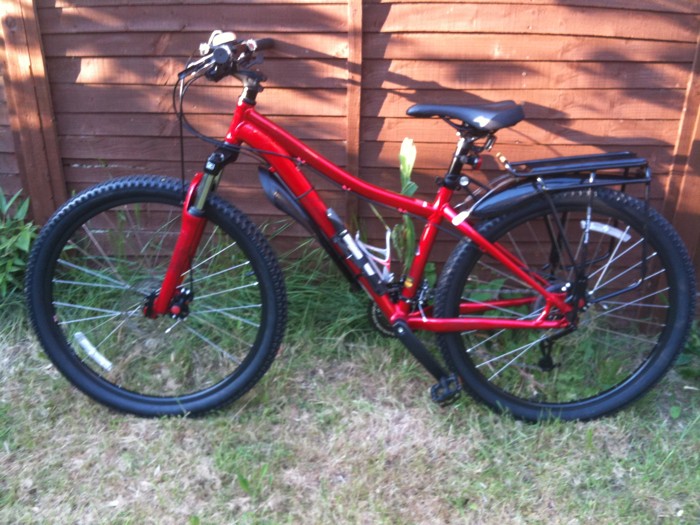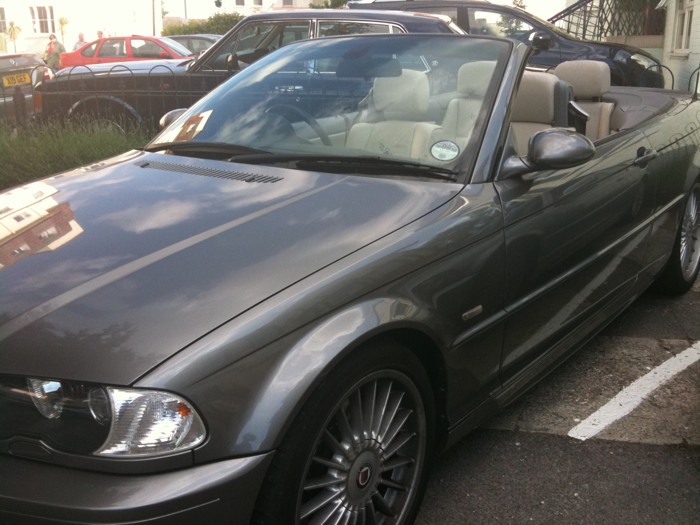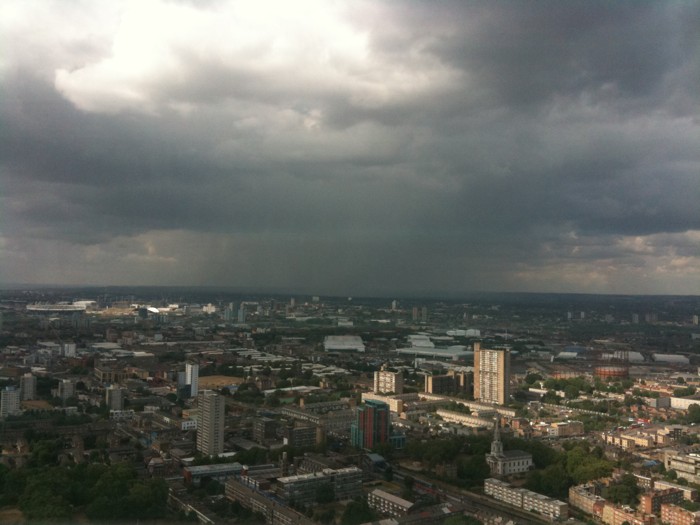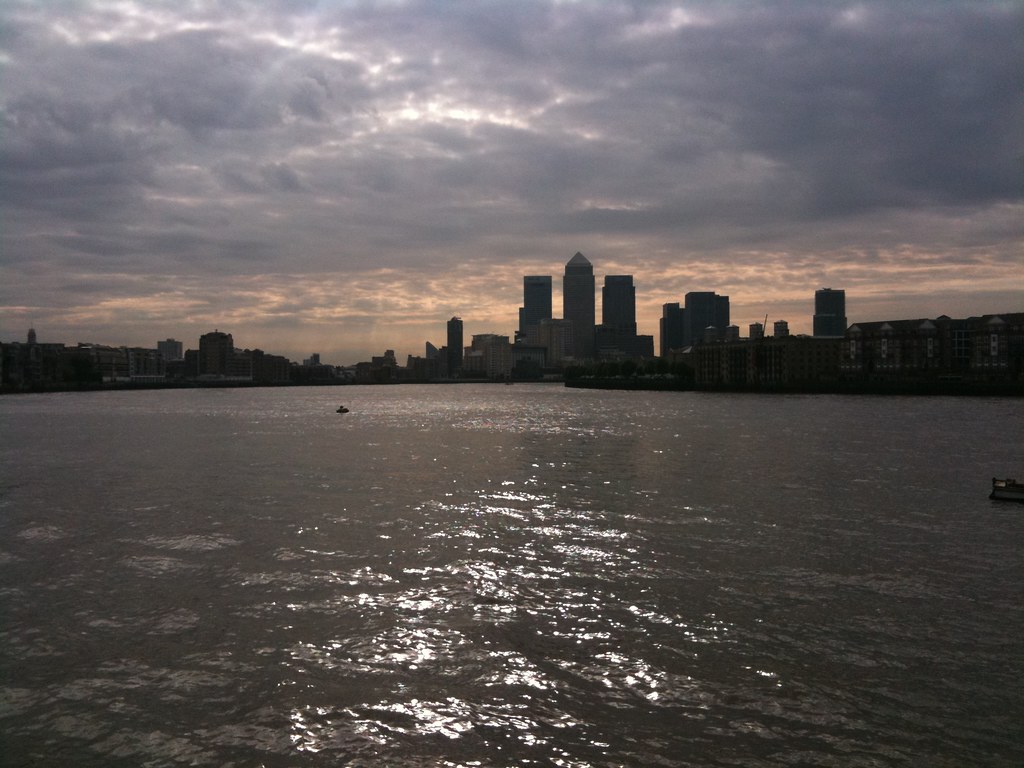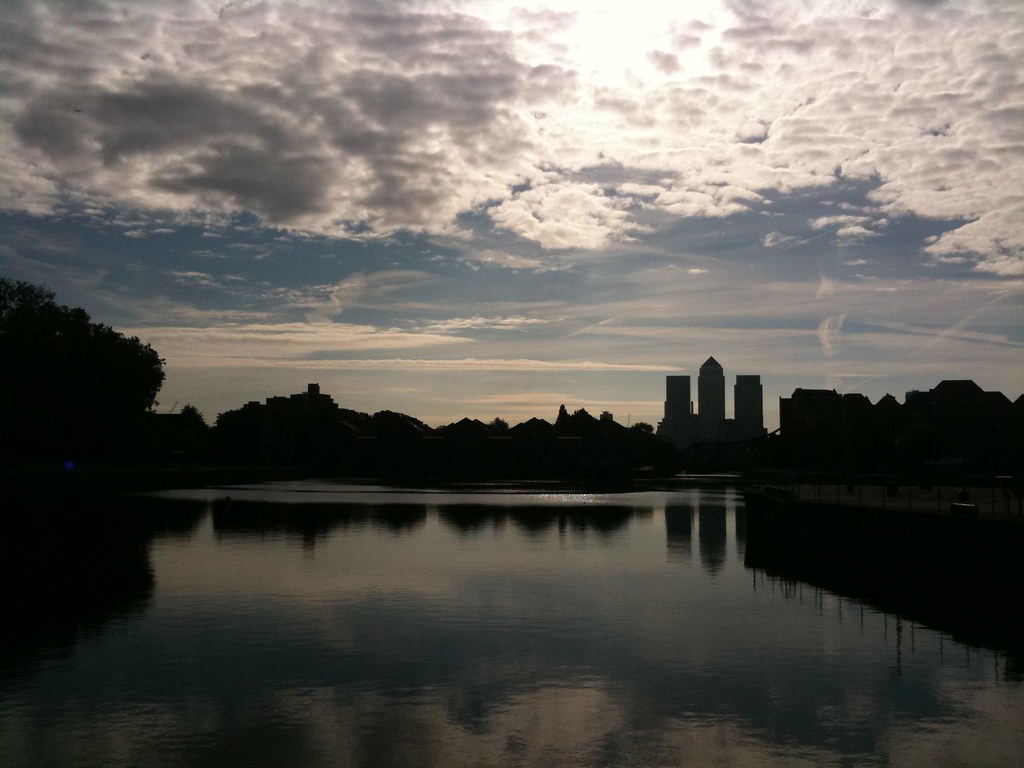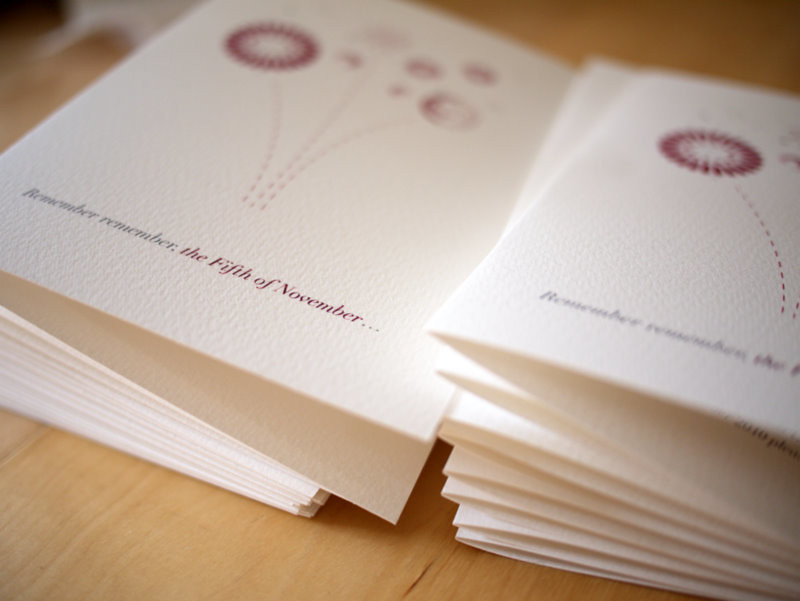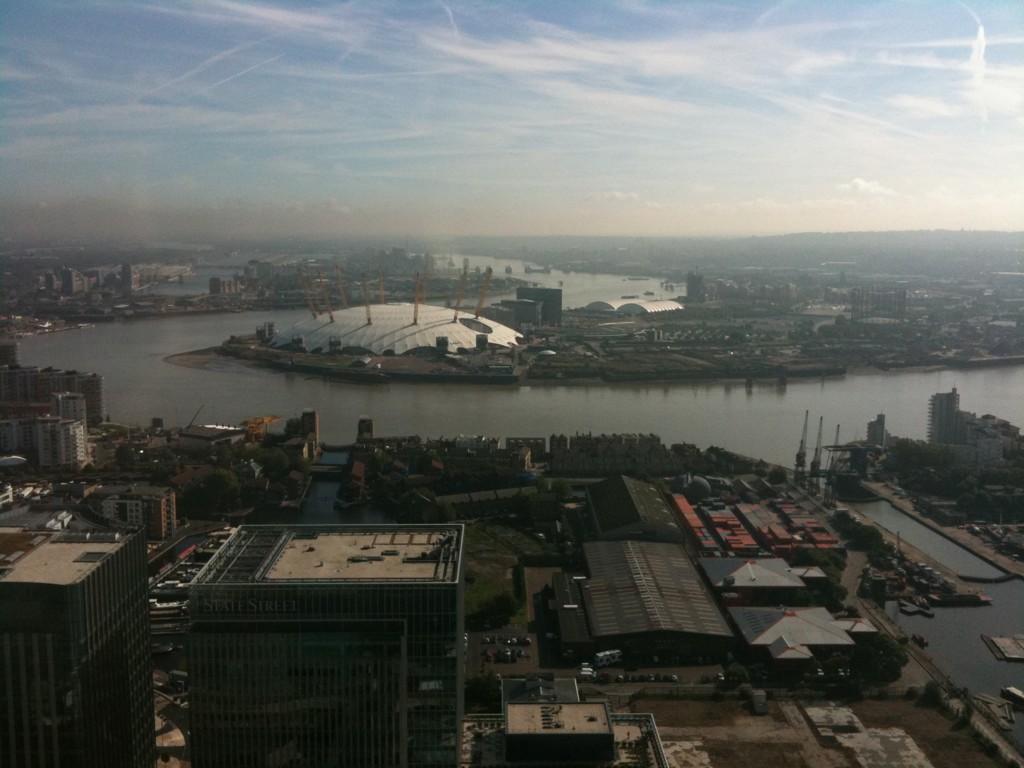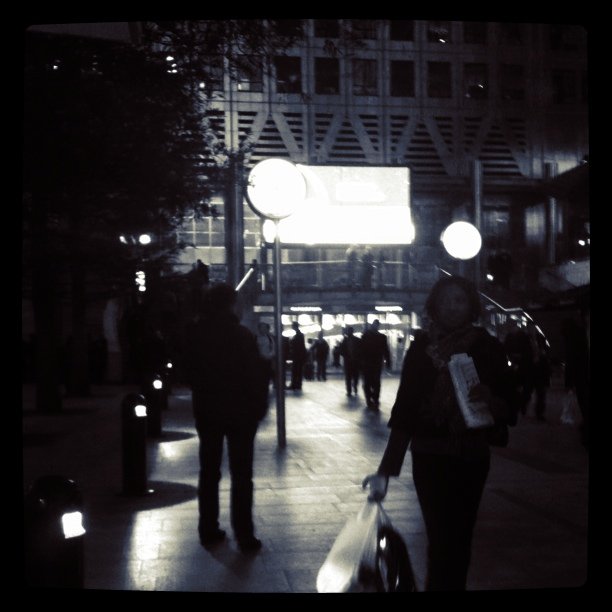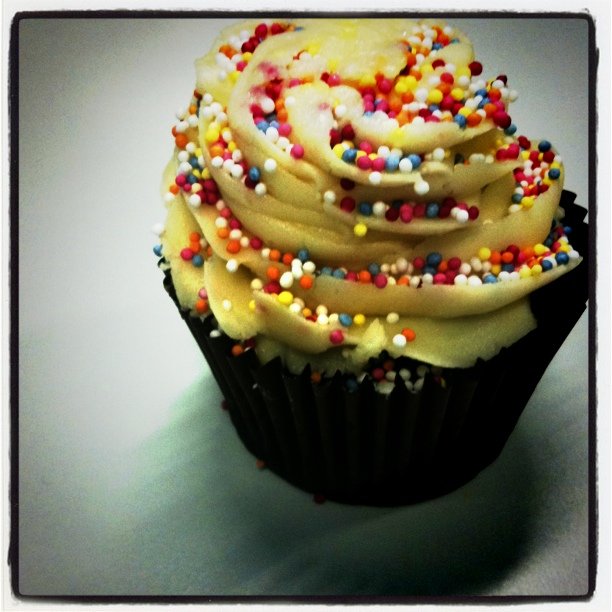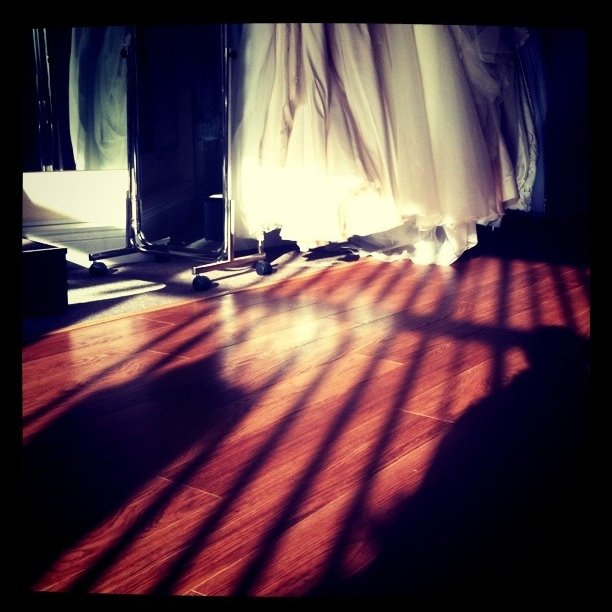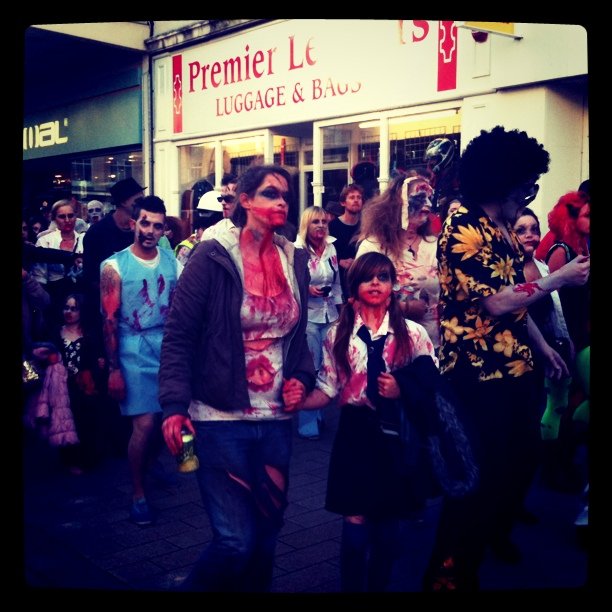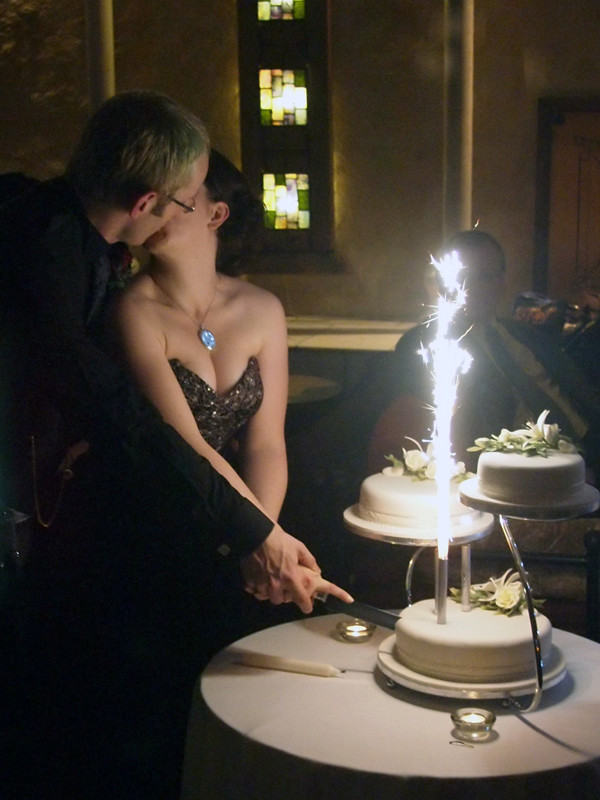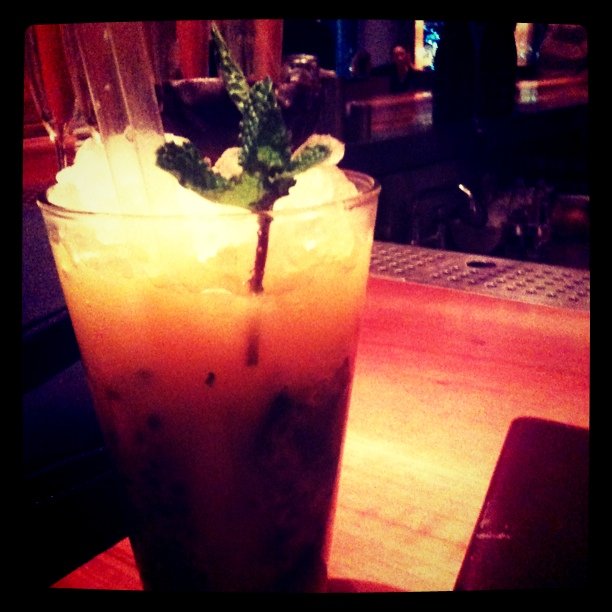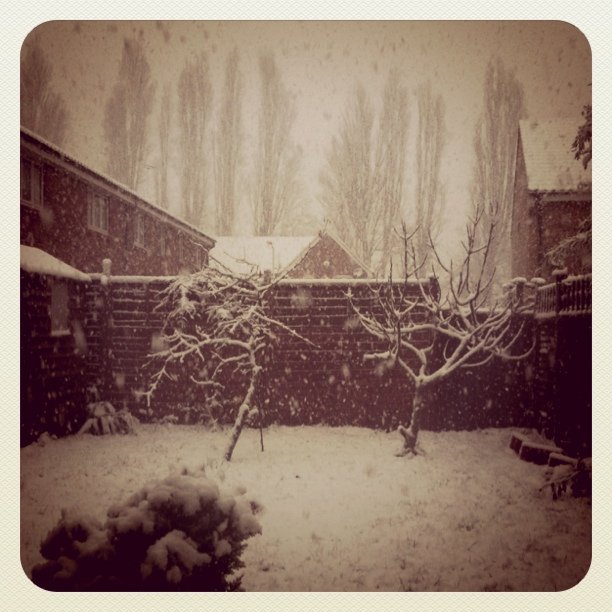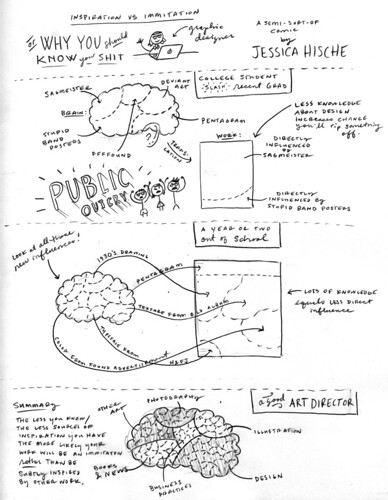Writing
It's oh so quiet. Shh.
Shh.
It's oh… so still…
…
…
The mud-coloured sea rolls ever inward.
Above the treeline the gulls swoop and wheel, dancing on the wind.
In the mist beyond the tree, a P&O Ferry appears, moving inexorably toward harbour.
It's cold here. The chill's cold fingers sneak between and beneath the layers intended to keep them at bay. I contemplate yet another trip up the stairs for yet another woolly item.
Instead, my eyes dart around, alighting on details like a hummingbird on an exotic flower.
Pause for a second.
Drink their nectar, then gone. On to the next thing.
The bright white of the kinked cable against the wood of the floor.
The rain-soaked picnic table and the tree reflected in its wetness.
The fake hydrangeas in their Delft-blue pots on the windowsill.
A discarded book, open on the rug.
The neon green and purple of my slippers, almost offensive against a landscape of muted neutrals.
The devil is in the details, they say.
There's something about being near water that makes me want to wax lyrical.
Travel too, especialy by train. There's a feeling of being apart from the world. In a kind of limbo - neither here nor there - that offers a freedom from the daily rhythmn of life. For a time, I march to a different beat.
The sound of the sea washes over me, and I am calm.
The words flow through my fingers and onto the page. I need them to. I want them to. They've been stuck in my head too long. Trapped there by a lack of time and space.
Life is busy. Sometimes too busy. Hours roll into days. Days roll into weeks. Weeks give way to weekends. A social life has appeared - fully-fledged - from nowhere obvious and is packed with occasions and/or obligations.
For the most part, I don't mind. It's nice to have things to do. People to see. To feel like a weekend has been had. But time alone is in short supply and I need it to recharge my batteries.
Not that I'm alone here. But with this company, this band of literary brothers and sisters, comes with the space to be in my alone in my head.
I came to write, and I do.
Sketching and Creativity: A Book List
Of all my bad habits, the worst (for my mental health and wellbeing, at least) has to be my endless ability to self-sabotage my creativity. The very instant that an idea starts to form, the massed bands of negativity and criticism start up with a rousing chorus of "Reasons Why It/You/Everything Will Fail" (second verse, same as the first) and within seconds, the spark dies before it's had a chance to become flame, never mind roaring fire.
Over the last couple of years I've been trying to counteract this behaviour, with varying degrees of success. I think I've become better at externalising my inner dialogue when collaborating with others and asking the questions that I usually answer in my head out loud. I've also become a bit better at sharing my personal work with a small circle of people I trust, but really feel that I need to work on making sure my inner critic doesn't monopolise the conversations I have with myself so I can be a bit braver in what I create.
In essence, I want to explore more creative, less safe solutions and push myself to go beyond the first safe thing or two I think of.
I often find it quite difficult to be creative for creativity's sake. I get the urge to be creative, but no specific need for something which require creativity. Knitting has often filled this gap, but isn't quite so instantly gratifying as I'd like, and even that isn't as brave as I could be. So to try and overcome this, I've been slowly building a collection of books relating to creativity.
In tandem, I've also been working on improving my visual communication, because an unfortunate and unwanted side-effect of my (perceived or actual - who knows) lack of technical ability when drawing has led to occasions where I cannot adequately communicate the concept in my head so I've also been slowly building a collection of books relating to sketching.
What prompted this post was an offhand tweet following one of those Amazon wormhole experiences where you start off buying one book and then follow a trail of recommendations and "other people bought this"es and before you know it you have ten books in your basket. @kelbyuk asked me to share the booklist, so here it is.
The following books I have already:
The Creative Habit - Twyla Tharp
I put this on my wishlist a couple of years ago and got it last Christmas. I'm a little bit ashamed to say that it came home and went up on the shelf where it has remained unread. I have no intention of getting to Christmas 2011 with it remaining unread.
The Advertising Concept Book: Think Now, Design Later - Pete Barry
I love how this is illustrated almost entirely in sketch and deconstructs various advertising campaigns. This was the book that really got me excited about the potential of good sketches to present work and ideas more quickly than an OmniGraffle session.
The Fundamentals of Drawing - Barrington Barber
Not just a fantastic name for an author, but a really great book taking you from the real basics through a number of exercises to full on proper drawings. I've read it but haven't, for reasons passing understanding, started doing any of the exercises yet. Must try harder.
The Back of the Napkin - Dan Roam
Bought because London UX Book Club were going to be discussing it. Didn't read it and didn't go to the Book Club. Shameful.
How to Draw Anything - Mark Linley
To go along with The Fundamentals of Drawing. Only arrived on Saturday.
It's Not How Good You Are, It's How Good You Want To Be - Paul Arden
Really great book. Bought it a couple of years ago, read it in one gulp. Could probably do with reading it again.
And these are the books that flew into my Amazon Shopping Basket:
Because I find looking at other people's sketches incredibly inspirational (as well as a little bit depressing in a "I'll never be as good as that" kind of way - hoping for more of the former and less of the latter). Now sold out. Curses.
The Creative License: Giving Yourself Permission to be the Artist You Truly Are - Danny Gregory
Because it looked interesting, got good reviews, and I feel like I could do with following a few exercises until I find my feet a bit more.
Sketchbook: Conceptual Drawings From The Worlds Most Influential Designers and Creatives
See above re: other people's sketchbooks.
How to Make a Journal of Your Life - Dan Price
Because I bought his book on Radical Simplicity on kindle and really liked the few short pages I managed to read before life intruded. Also because I've been enjoying sketchnoting and like the idea of sketchnoting my life.
Not sure about this one (the cover is… uninspiring, to say the least), but this goes to the heart of what I'm trying to do more of at work - communicate visually for when words aren't enough.
Wreck This Journal: To Create is to Destroy - Keri Smith
Because I fetishise notebooks too much.
Mess: The Manual of Accidents and Mistakes - Keri Smith
Because the exercises seem like fun, and because I loved doing the teabag sketch at Eva-Lotta Lamm's London IA sketch workshop and this reminded me of that.
So there you go, a few books on sketching and creativity. Are there any others I should really know about? Comment or @pixeldiva on twitter and I'll add them to this list.
Venus, Reflected
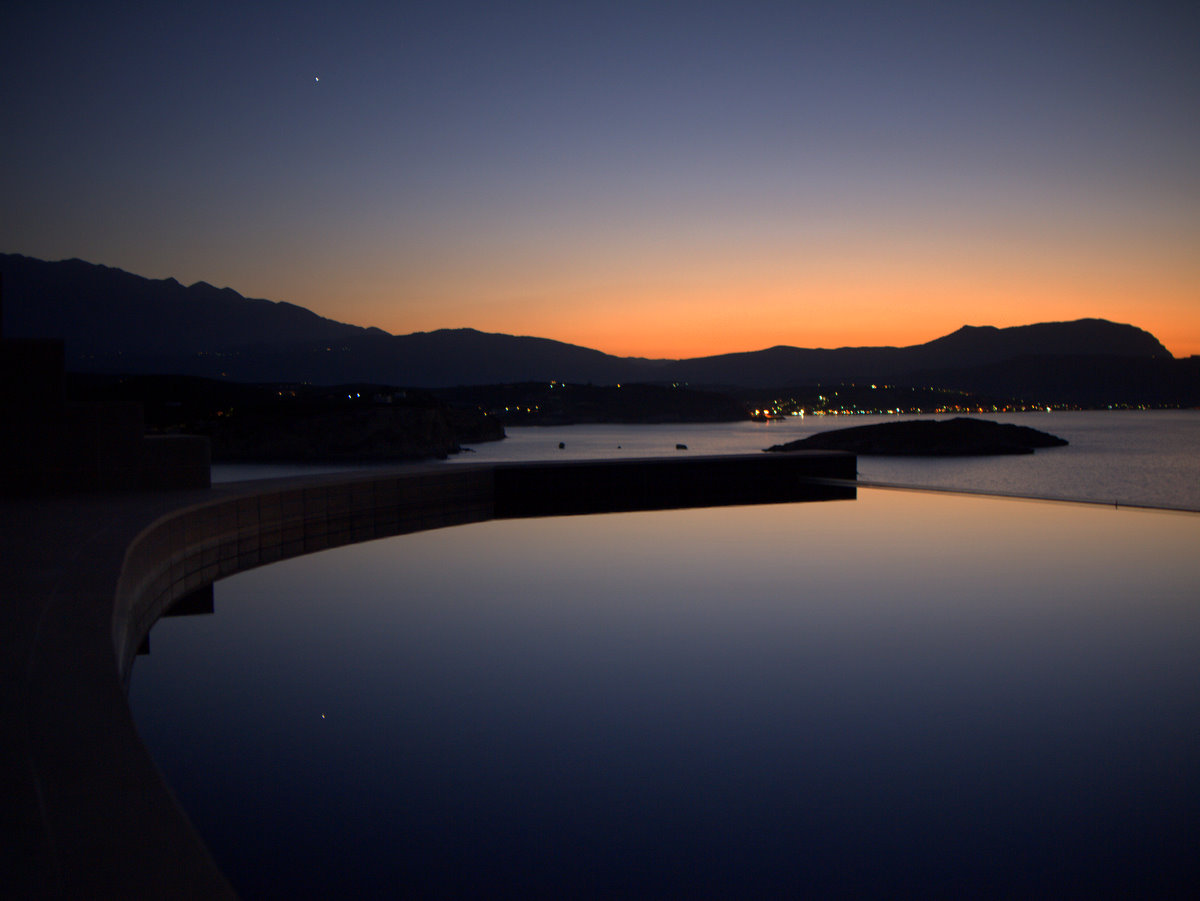 One of the reasons I love Instagram so much is that it makes it super easy to upload photos that are closer to what I saw when I was inspired to take a photo than what the camera was able to capture in raw data.
One of the reasons I love Instagram so much is that it makes it super easy to upload photos that are closer to what I saw when I was inspired to take a photo than what the camera was able to capture in raw data.
Sure, the iPhone camera quality is pretty rubbish and it is in no way a substitute for my beautiful Lumix GF1, but it not only captures the moment and the mood, but makes it easy to share the moment, before the moment is lost.
I spent a couple of weeks in Crete at the end of August/Beginning of September last year. It involved rather more relaxing than I planned (I got flu on day 4 and was properly ill for the majority of the rest of my stay, including my birthday) and had rather less internets than I was expecting, which meant I took a bunch of pictures, downloaded them onto my laptop and then did nothing with them.
The above photo was taken one beautifully clear night and for once, the straight out of camera shot matched what I "saw" (for the most part) when I was moved to pick up the camera and spent the next few minutes being gently mocked by my in-laws as I lay on my stomach next to the pool snapping away.
Among the dark and gloom of January, it reminds me that there was sun and will be again.
Resolved
In 2011, I will:
- Get more sleep.
- Find better work/life balance.
- Do more exercise.
- Make better choices about food.
- Listen more.
- Talk less.
- Do more "one minute" chores immediately.
- Learn new things.
- Be less critical.
- Be more supportive.
- Create more.
- Fail more.
- Worry less.
- Enjoy myself, because life is too short not to.
A Bramley Shawl
I've been seeing in the New Year with friends who live in the village of Bramley in Hampshire and and it's inspired me to knit a shawl with some very special yarn that was hand spun for me a couple of years ago and was just calling out to be used. I spent several hours combing Ravelry for the right pattern but couldn't find something that really seemed perfect for it, because it's quite a variegated yarn, though I have been inspired by many different shawls, particularly the Textured Shawl recipe by Orlane (Ravelry link).
So I thought that it might be fun to blog the pattern as I knit it. Part public note of what I did, part pattern for anyone else who might be crazy enough to join me on a very random, but hopefully, simple, elegant and attractive shawl knitalong.
So here goes.
Use whatever combination of yarn and needles makes you happy.
I'm using 6.5mm and a handspun yarn that feels like heavy sock weight, possibly 4ply and intend to knit until I run out of yarn. I have no idea of the yardage but I've got about 140g of it.
Cast On 3 stitches (sts) Knit (k) 12 rows Pick up and knit 10 sts along long edge and 3 sts from cast on edge
This gives a lovely garter stitch border along the top of the shawl and is worth the fiddliness of the picking up and knitting.
K3, yarn over (yo), purl (p) to last 3 sts, yo, k3
Section 1
K3, yo, [k3, yo, k1, yo] x3 yo, k3 Next and all wrong side rows: K3, p to last 3sts, k3
Begin all right side rows with k3, yo and end with yo, k3
Repeat the following 3 times for each right side row K5, yo, k1, yo K7, yo, k1, yo K9, yo, k1, yo Etc.
The number of stitches in each repeat increases by 2 each row. Continue until there are 21 sts in each repeat before the spine [yo, k1, yo]
Section 2 [this section subject to change - it isn't working the way I hoped it would]
Knit 2 together (k2tog), yo to last stitch before the spine, k1
K1, yo, k2tog through back loops (k2tog tbl) to spine
Repeat these two rows 4 more times
Section 3
(To Be Continued)
2010: A Year of Fireworks
I don't write as much as I used to. I don't remember as much as I used to.
As the wonderful Field Notes notebooks remind me:
I’m not writing it down to remember it later. I’m writing it down to remember it now.
2010 was an epic year for me, for many reasons and while on one hand it's a good thing that I lived it so thoroughly rather than stepping back and being an observer, I don't want to forget it either, so inspired by the incomparable Jon Tan, and with a little nod to the "Agile" world in which I work, I'm writing my retrospective.
January
2010 began with Fireworks, setting, though I didn't realise it at the time, the theme of the year. After many, many years of watching them on television, I finally saw the London New Year fireworks in person (despite having lived here for more than eight years), courtesy of the Royal Festival Hall's New Year Party.
However, Pirates, Ceilidh-dancing, Fireworks and Bellinis all too quickly gave way to Airports and International Travel as I jetted off to Singapore for the second time in a month on the 2nd of January.
I've travelled for work a bit before, but never so far, or in such relative luxury, so the experience was quite the culture shock. As if the travel culture shock and jet lag wasn't enough, I then spent a week 31 floors above Singapore in one of the noisiest working environments I can imagine - the trading floor of a major international investment bank. I left there every day with a blinding headache from all the noise, and at the end of the week with a much better understanding of the needs of the people it's now my job to design applications for.
On a personal level, I got geekily over-excited about staying at the Fullerton Hotel, which sits on one of the most exciting parts of the Singapore Formula 1 race-track, ate amazing food (seriously, didn't have a crappy meal the whole time I was there), saw some stunning cityscapes and took lots of photos.
Two weeks later, another bank, a crocheted hat and January gave way to…
February
February started well. I was on a high from the successful end of the Singapore assignment at work and learning to use my new Sewing Machine with a cushion-making class at The Make Lounge.
Valentine's Day was spent with my fiance and a Champagne Tea at Liberty (a new tradition) and all was well.
Then work got a bit more complicated and stressful and my third attempt to do a 365 Photo Project came abruptly to a halt a mere 46 days into the year.
March
The beginning of March is probably best forgotten, though I've learned a lot from what went wrong in those two weeks. It picked up mid-month when we visited the incredibly talented Chris Parry to collect the engagement ring we commissioned for me from him.
It ended fairly quietly, with some gentle knitting with friends, and a trip to North Devon to spend Easter with my soon to be in-laws.
April
April was a pretty eventful month. A couple of days after Easter I was admitted to hospital to have my gallbladder removed. It had been giving me problems for a while and had (I realise now) packed up completely a few weeks earlier, so it was good to get rid of it when I did, even if the timing was a bit off, coming, as it did, a week before the Big Scary Gathering of The Families, where our combined families all met for the first time.
It was quite a momentous weekend for other reasons though. Thanks to the lovely Laura Francis, who dragged me to Collage Green Bridal, I found my wedding dress. I've never been a super girlie-girl, but the second I put that dress on, I knew it was The One. An unexpectedly emotional moment.
We spent the weekend as a combined family, getting to know each other and viewing wedding venues and the business of organising our wedding began to get underway properly.
The rest of the month was spent recovering from my surgery and easing back into work.
May
In May, still recovering from surgery, I started a new long-term assignment at work and went to UX London and took my first, faltering, sketchnoting steps.
I whooshed past my six-month anniversary at work and began down the road of really trying to make UX work in a large, agile project, in a domain where I had no previous knowledge or expertise, so things were a bit quiet as I tried to get my head around all the new stuff I suddenly needed to know.
I did manage to get myself a shiny new Bicycle though.
K's birthday at the end of the month brought some new excitement as we headed into…
June
K took delivery of his dream car, a BMW Alpina B3S Convertible, bought from a friend and ex-colleague a mere hour before midnight on his birthday and so began the summer of headscarves and remembering to put sunscreen on before getting in the car.
Wedding planning continued apace, and I scared myself silly on the company summer outing to Go Ape. I'm really not good with heights.
I got an iPad and amazed myself at how awesome technology is now, by watching the European Grand Prix Qualifying Session on the iPad, via 3G while sitting in the passenger seat of the car, en-route to stay with a friend for the weekend.
The month ended with some improved sketchnoting at a London IA meeting and a trip to Macclesfield.
July
July was Working, Wedding Planning and Weekends with Friends.
It rained a bit, and I got up the confidence to start cycling to work.
August
By August, the toll of Working and Wedding Planning was beginning to tell, but the cycling was getting easier, and I started to really enjoy it.
Attending a friend's wedding mid-month made our own impending wedding seem so much more real and was a really lovely event, especially seeing the parade of hangovers the next day.
After much dithering about the design, the Wedding invitations went out, and the Fireworks made a re-appearance.
The end of the month saw us in Crete, for a desperately needed holiday. Unfortunately, Murphy's Law of not taking holidays kicked in and I spent most of it in bed with a flu type illness which was so bad I wasn't even well enough to celebrate my birthday.
September
September saw us take a trip Up North to spend one of our last precious weekends before the wedding with friends and pretty much directly led to the purchase of a pair of Jimmy Choo shoes for the wedding.
I got my make-up done professionally for the first time and came out of the shop significantly lighter in the wallet than I went in, but looking the best I think I've ever looked. What a revelation.
A meeting at the end of the month reminded me how awesomely cool some of the views in Canary Wharf can be, and how lucky I've been to be able to see them.
October
October started with a mad rush to Bristol to finalise the details for the wedding. I went back to the dress shop to get my dress fitted and fell in love with it all over again.
I discovered Instagram and the month flew by in a blur of Work, Emergency Cake and Weddings (the planning of ours and the attending of a Uni Friend of K's), ending in a trip to Bristol for the final dress fitting and wedding hairdo trial, via a Zombie attack.
The amazing Mike and Christine arrived from Houston, Texas to photograph the wedding (and stop me from going batshit mental in the week before the wedding).
November
I managed not to freak out (too much) getting all the bits and pieces together to take to Bristol for the wedding and at 5pm on the 5th of November - Guy Fawkes Night - I married the love of my life in a candle-lit ceremony in Byzantium Restaurant in Bristol surrounded by family and friends.
Later, the fireworks made another appearance as we cut the cake.
Photos by R
The party went long into the night (and for some, into the next morning) and we staggered back to work a few days later a bit giddy with the excitement of it all.
The tail end of the month saw work kick back in big style with the first public release of the software I've been working on and me doing a workshop on Agile UX at the UX People conference, which started off rockily but improved exponentially as the day went on and which inspired me to get out and do more next year.
December
December began with snow and party frocks and wellies, continued with more snow, another public release of our software at work and slowed down for a quiet family Christmas with the in-laws.
As I write this, my husband is packing the car and we're about to head off to spend the New Year with friends.
It's been an amazing year and these are only a fraction of the memories that I'll be taking forwards into 2011.
Have a fabulous New Year.
See you on the other side.
Beautiful Design for Everyone
This is an abridged text version (more or less) of the talk I gave at the London Web Standards meetup in May which I always intended to write up, but between work and planning a wedding, kind of fell by the wayside. There were 49 slides and because my friend and fellow speaker Antonia Hyde had to pull out I expanded the talk beyond its original time slot of 45 minutes so while I've tried to be as concise as possible in the notes accompanying each slide, you might want to grab yourself a cup of tea (or other beverage of choice) before you start reading.
So, if you're sitting comfortably, let's begin.
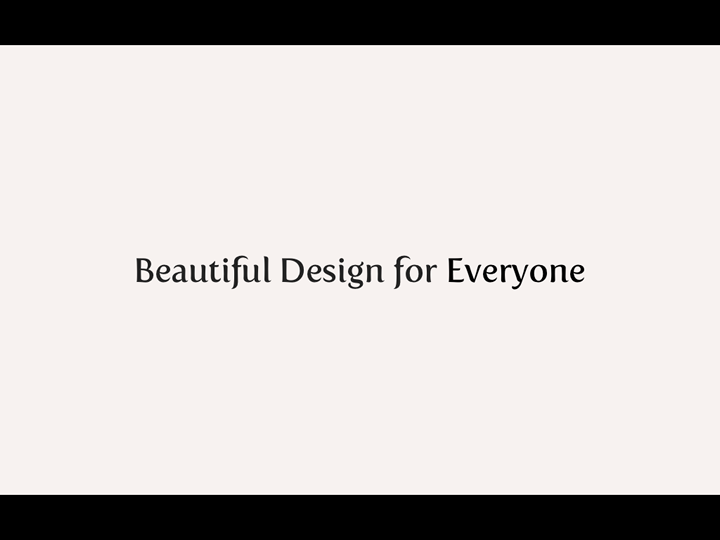
Beautiful Design for Everyone
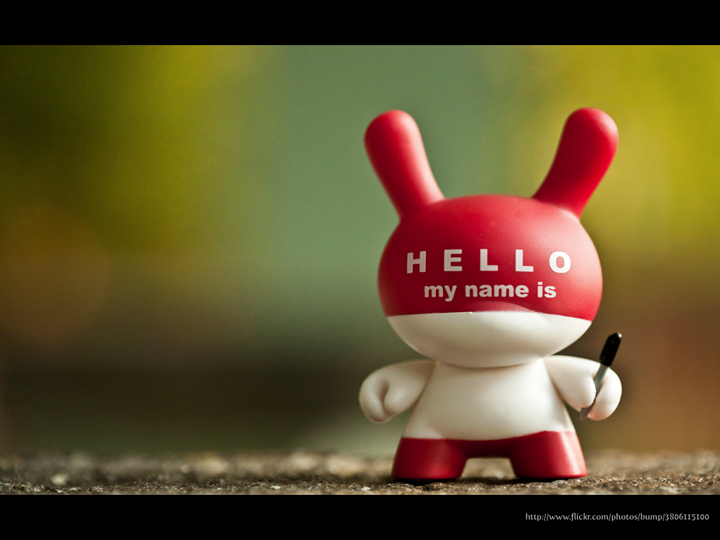
Hello, My Name is Ann and I'm a recovering Accessibility Consultant.

Over the years I've talked about accessibility a lot, and I used to tell people that I had a passion for accessibility, and I really believed it. When I found myself working at RNIB and discovered that I could get paid for talking about this passion, I thought that it was my dream job. For a while, it really was. I did then, and still do, get a buzz from seeing careful design empower someone who has been been experiencing difficulty in a particular area, but what it made me realise over the years was that it wasn't accessibility I was passionate about, it was good design.
To me, good design is inclusive.
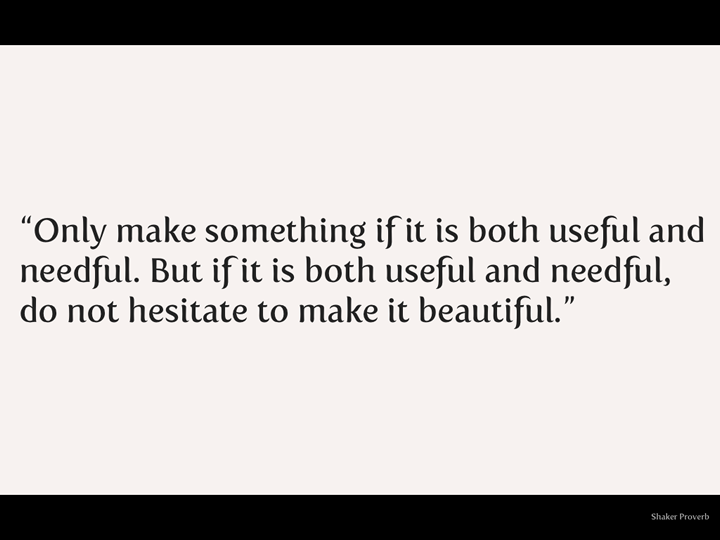
There's a famous Shaker Proverb that I love. It says:
"Only make something if it is both useful and needful. But if it is both useful and needful, do not hesitate to make it beautiful."
This, more than any form of words I've yet been able to come up with, encapsulates my design philosophy. After all, beautiful things make people happy. Useful, needful, beautiful things most often come about as a result of careful thought, understanding and skill from people who care about solving problems, not from ticking boxes on a checklist. That's why it's called design, not manufacture.
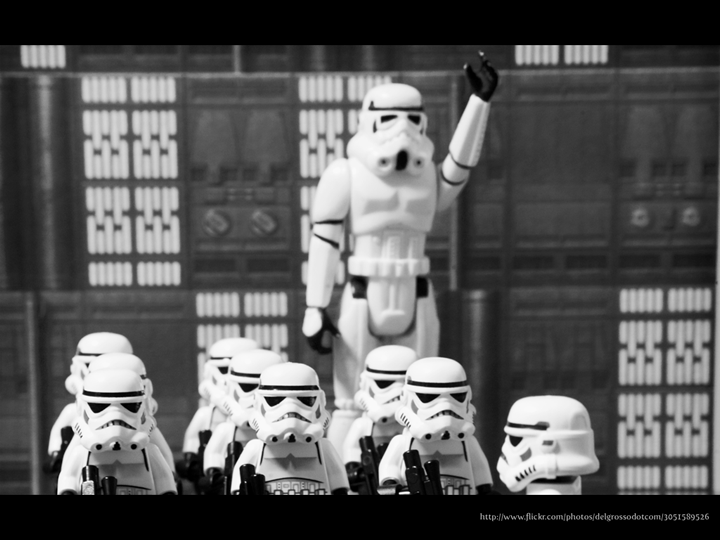
Raise your hand (mentally if you're in a public place and don't want people to stare at you) if you think of accessibility as being beautiful.
Did you raise your hand? Even in your head?
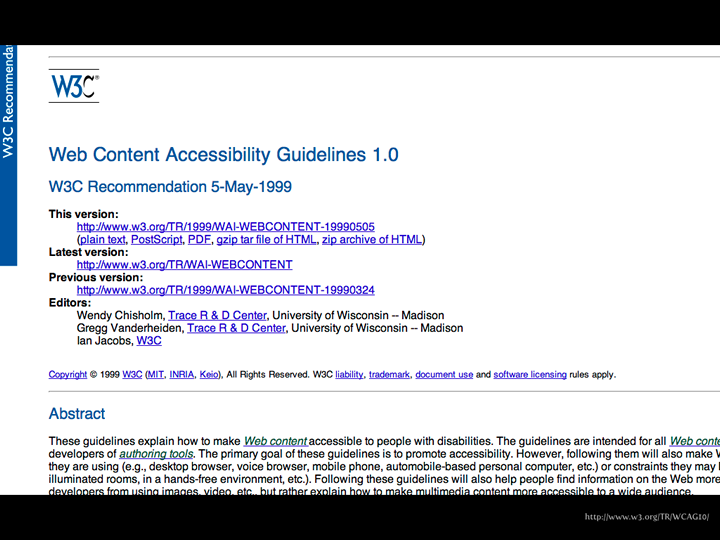
Did you think of things like the W3C Web Content Accessibility Guidelines?
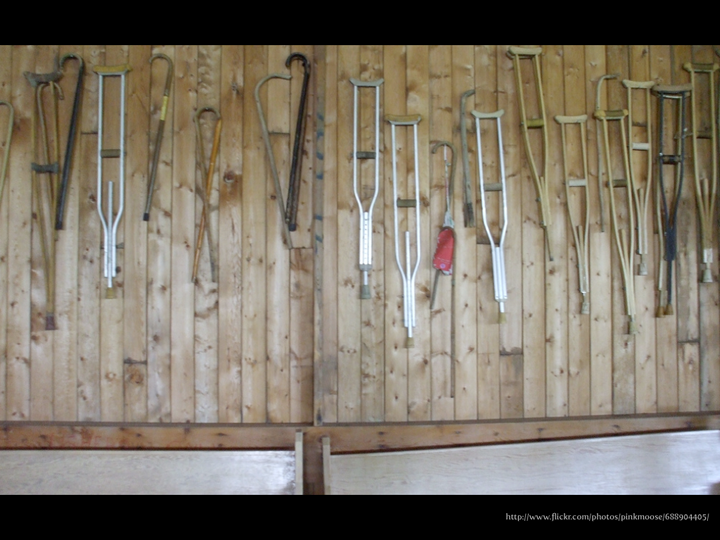
Or maybe assistive items like crutches?
That's ok.
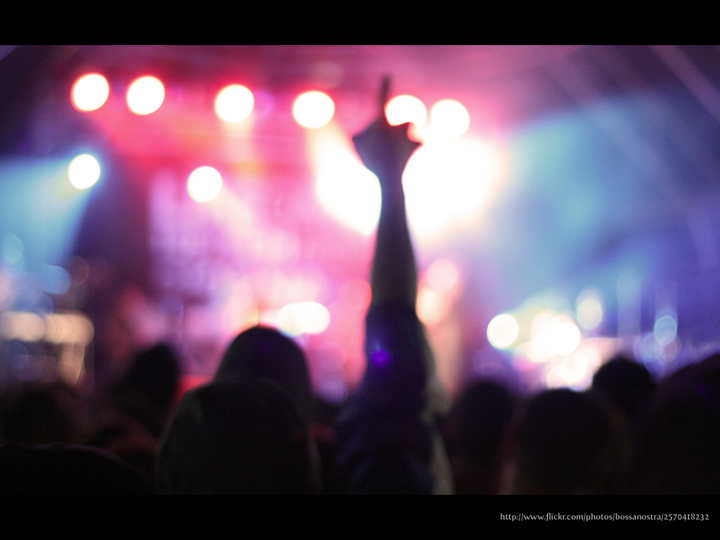
Raise your hand if you're a designer (or a developer) and feel constrained by having to "do" accessibility. Or if you fear that "doing" accessibility will make your work or the experience you are creating lowest common denominator, boring or ugly for everyone else.
Don't worry, there's no judgement here. You can be honest.
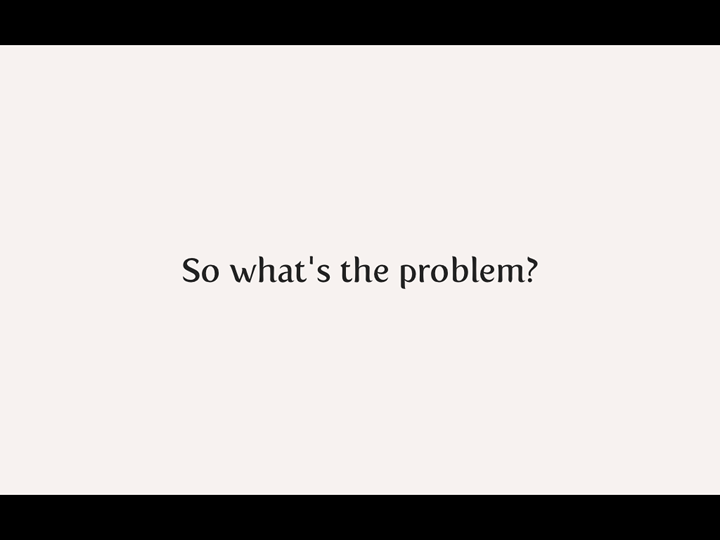
So what's the problem?
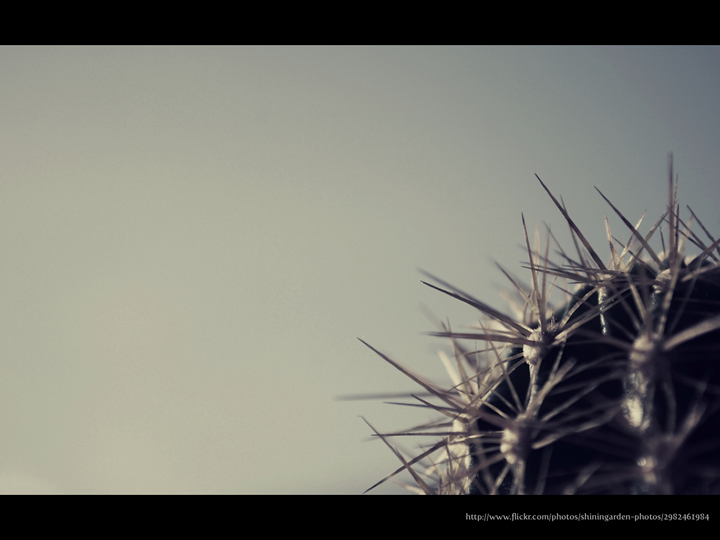
The problem with accessibility is that when you start thinking about it, it's only natural to start thinking about disability, and that can be uncomfortable.
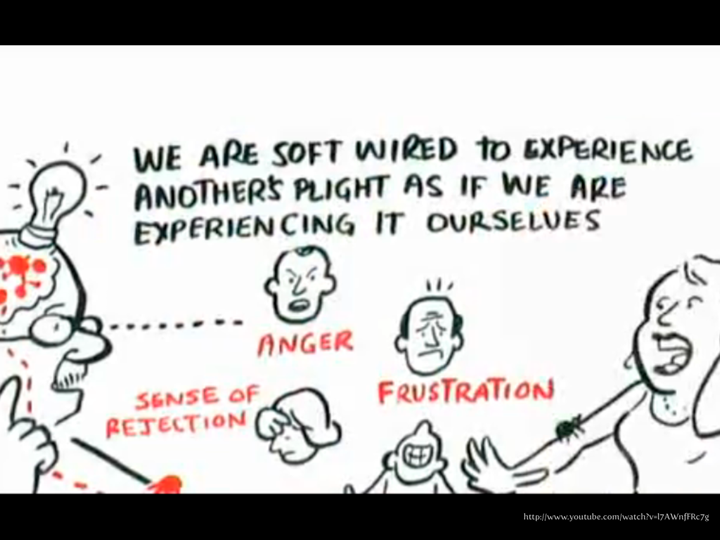
That's not a bad thing and it doesn't make you a bad person. In fact, it's perfectly natural. You can't help it. It's called empathy and it turns out that we are an empathic civilisation (this is an awesome video, do make a note to watch it when you're done reading, or open it in a new tab now so it will have done buffering and be ready when you are).
We are soft wired to experience another's plight as if we are experiencing it ourselves.
It's ok to empathise, but all too often I've seen people get so caught up in their empathy that it has lead them off the path to understanding the real needs of the user and prevented them from solving the problem at hand.
I can still remember the first time I saw a blind person using a screen reader. I'm pretty sure my mouth dropped open in astonishment and my only thoughts were what a horrible experience it was which lead to thinking about what it might like to be blind, which led to me feeling uncomfortable as I felt sorry for anyone who was blind because I couldn't imagine how I would cope and how I would put up with this awful experience and simultaneously felt glad that I had my sight. This was closely followed by feeling ashamed of myself for feeling like that.
What I didn't understand that first time (or second, third, fourth or probably fifteenth) was that not only had I failed to see that they had developed expert skills and could process auditory information far faster than I could ever hope to, but that while this expert skill gave them the freedom that I, in my naiveté had assumed would be lost.
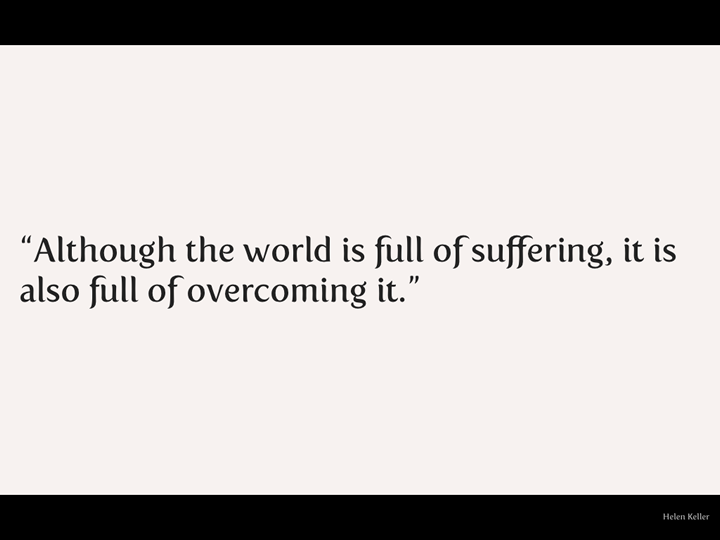
Helen Keller, who was deaf and blind, said:
"Although the world is full of suffering, it is also full of overcoming it."
Humans are incredibly adaptive. Yes, having a disability (if I use the medical model of disability, which describes disability as "a sociopolitical model by which illness or disability, being the result of a physical condition, and which is intrinsic to the individual (it is part of that individual’s own body), may reduce the individual's quality of life, and causes clear disadvantages to the individual.") can be painful and frustrating, but people with disabilities don't just sit around feeling sorry for themselves waiting for someone to come along and help them, and actually, that's a pretty crappy way to think of it. Whereas the social model of disability, which "identifies systemic barriers, negative attitudes and exclusion by society (purposely or inadvertently) that mean society is the main contributory factor in disabling people. While physical, sensory, intellectual, or psychological variations, may cause individual functional limitation or impairments, these do not have to lead to disability unless society fails to take account of and include people regardless of their individual differences" is more likely to be the case.
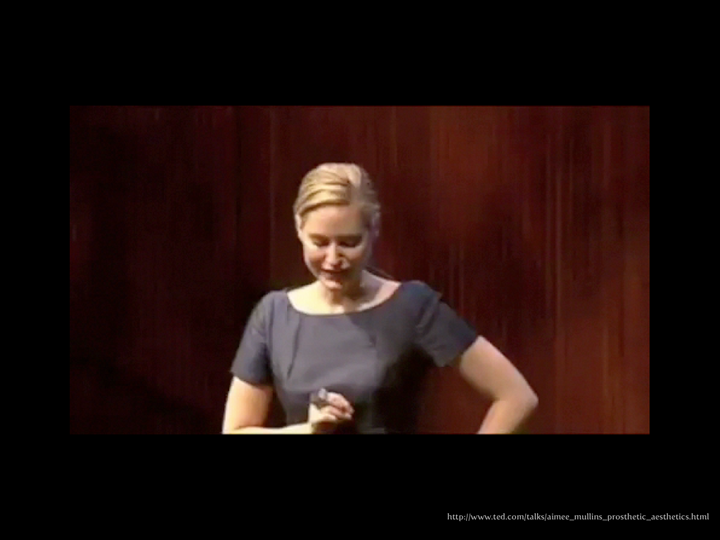
Aimee Mullins is an inspiration to me. If you don't know who she is, you're in for a treat. I could write paragraphs about her but it's going to be much more effective if you experience it for yourself.
I've embedded the video here for ease of use, but if you prefer to read the transcript, it's below the video (or you can watch Aimee Mullins and her 12 pairs of legs on TED.com). It's ten minutes long. You can stop watching (if you want to) after four and a half minutes, because that's the clip that I showed/talked about on the night, but the whole thing is incredible and definitely worth watching.
I was speaking to a group of about 300 kids, ages six to eight, at a children's museum, and I brought with me a bag full of legs, similar to the kinds of things you see up here, and had them laid out on a table, for the kids. And, from my experience, you know, kids are naturally curious about what they don't know, or don't understand, or what is foreign to them. They only learn to be frightened of those differences when an adult influences them to behave that way, and maybe censors that natural curiosity, or you know, reins in the question-asking in the hopes of them being polite little kids. So, I just pictured a first grade teacher out in the lobby with these unruly kids, saying, "Now, whatever you do, don't stare at her legs."
But, of course, that's the point. That's why I was there, I wanted to invite them to look and explore. So I made a deal with the adults that the kids could come in, without any adults, for two minutes, on their own. The doors open, the kids descend on this table of legs, and they are poking and prodding, and they're wiggling toes, and they're trying to put their full weight on the sprinting leg to see what happens with that. And I said, "Kids, really quickly -- I woke up this morning, I decided I wanted to be able to jump over a house -- nothing too big, two or three stories -- but, if you could think of any animal, any superhero, any cartoon character, anything you can dream up right now, what kind of legs would you build me?"
And immediately a voice shouted, "Kangaroo!" "No, no, no! Should be a frog!" "No. It should be Go Go Gadget!" "No, no, no! It should be The Incredibles." And other things that I don't -- aren't familiar with. And then, one eight-year-old said, "Hey, why wouldn't you want to fly too?" And the whole room, including me, was like, "Yeah." (Laughter) And just like that, I went from being a woman that these kids would have been trained to see as "disabled" to somebody that had potential that their bodies didn't have yet. Somebody that might even be super-abled. Interesting.
So some of you actually saw me at TED, 11 years ago, and there's been a lot of talk about how life-changing this conference is for both speakers and attendees, and I am no exception. TED literally was the launch pad to the next decade of my life's exploration. At the time, the legs I presented were groundbreaking in prosthetics. I had woven carbon fiber sprinting legs modeled after the hind leg of a cheetah, which you may have seen on stage yesterday. And also these very life-like, intrinsically painted silicone legs.
So at the time, it was my opportunity to put a call out to innovators outside the traditional medical prosthetic community to come bring their talent to the science and to the art of building legs. So that we can stop compartmentalizing form, function and aesthetic, and assigning them different values. Well, lucky for me, a lot of people answered that call. And the journey started, funny enough, with a TED conference attendee -- Chee Pearlman, who hopefully is in the audience somewhere today. She was the editor then of a magazine called ID, and she gave me a cover story.
This started an incredible journey. Curious encounters were happening to me at the time; I'd been accepting numerous invitations to speak on the design of the cheetah legs around the world. People would come up to me after the conference, after my talk, men and women. And the conversation would go something like this, "You know Aimee, you're very attractive. You don't look disabled." (Laughter) I thought, "Well, that's amazing, because I don't feel disabled." And it really opened my eyes to this conversation that could be explored, about beauty. What does a beautiful woman have to look like? What is a sexy body? And interestingly, from an identity standpoint, what does it mean to have a disability? I mean, people -- Pamela Anderson has more prosthetic in her body than I do. Nobody calls her disabled. (Laughter)
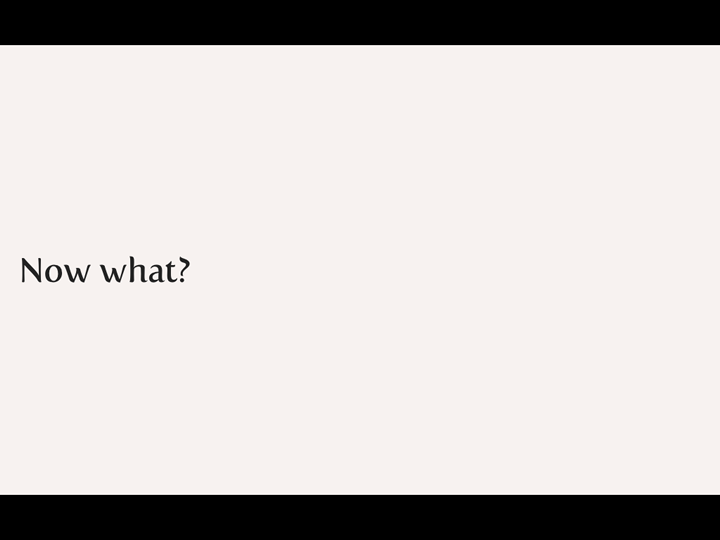
Now what?
Well, it's hardly fair of me to talk about problems without talking about solutions, but this isn't going to be a regurgitation of the WCAG guidelines, because, let's face it, guidelines and tedious. They're a great reference but not really the first (or fiftieth) thing you're likely to turn to if you're looking for some inspiration.
What I want to share is not so much about specific techniques, because although some of them are useful, technology changes so fast that they're likely to be out of date pretty soon, so I'd much rather talk about a loose framework of things to keep in mind. Go some way towards teaching you to fish rather than give you a fish, if you will.
I've broken this loose framework into four areas: Structure, Alternatives, Flexibility and Equivalents, and first up is:
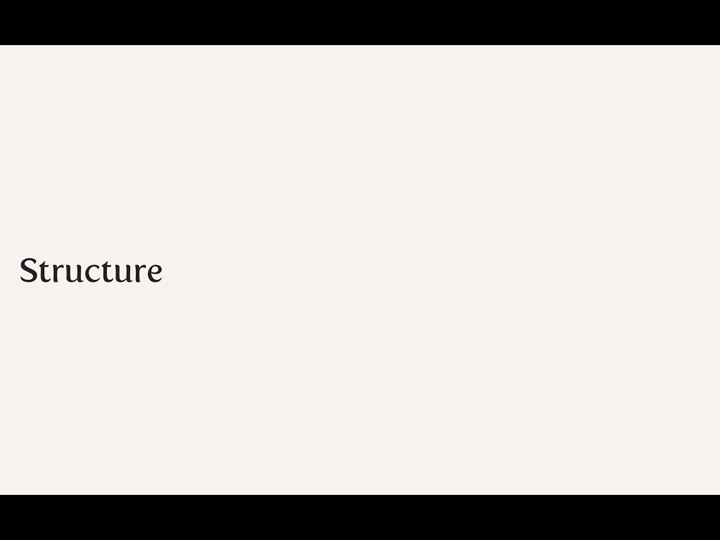
Structure
This is fundamental.
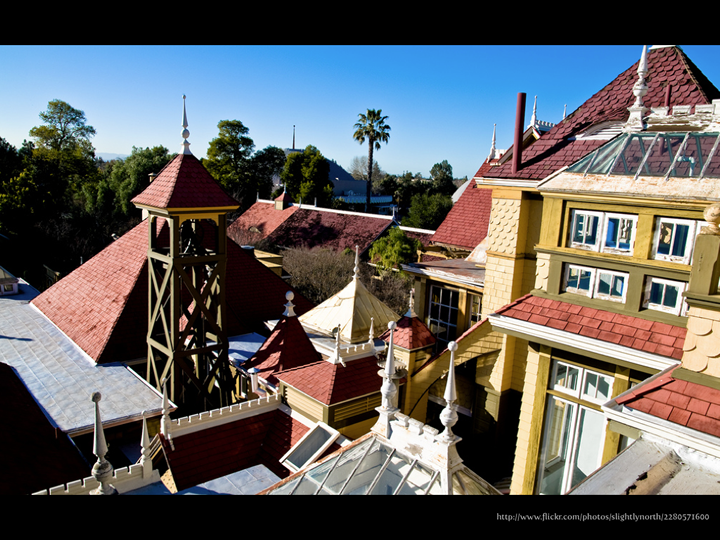
This is the Winchester Mystery House, which I learned about from Peter Morville, who talked about it in his presentation on Search Patterns at UX London.
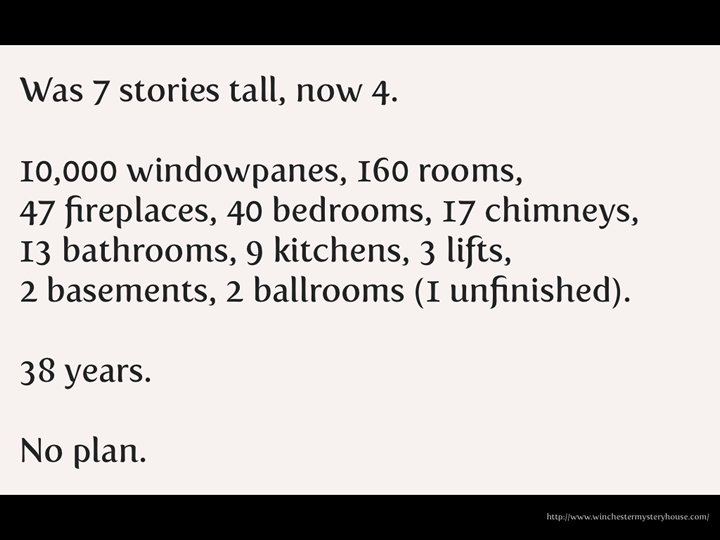
Some stats about the house:
Was 7 stories tall, now 4.
10,000 windowpanes, 160 rooms, 47 fireplaces, 40 bedrooms, 17 chimneys, 13 bathrooms, 9 kitchens, 3 lifts, 2 basements, 2 ballrooms (1 unfinished).
38 years.
No plan.
The poor woman who built the house had been told that if she stopped building the house that she'd die, so she kept on going. It's apparently nigh on impossible to navigate around, and has doors opening onto brick walls and passages that lead nowhere. All of which is a not particularly subtle metaphor for a website with really bad Information Architecture.
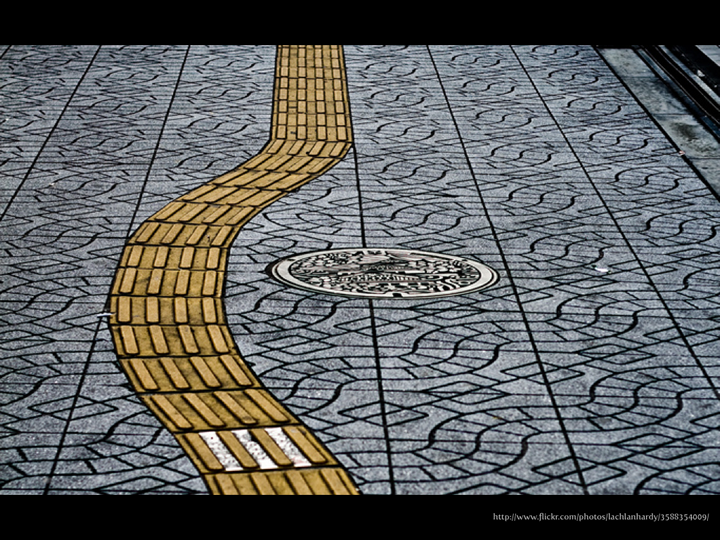
However, even with the best structure possible in place, you might need to put some wayfinding in place, but that's ok, because it doesn't have to be ugly and stick out like a sore thumb. It can be beautiful, like this tactile paving.
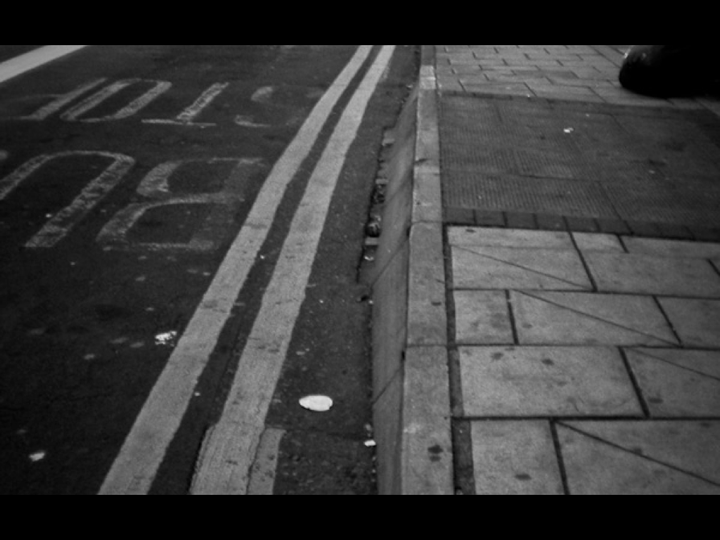
It doesn't need to be just for people with disabilities either. I spent a couple of weeks commuting in Bristol before I realised that most bus stops have this type of ramp built into them. I’ve never once in all the time I was there (or have been there since) seen anyone in a wheelchair use them, but I've seen loads of parents with buggies use them, and I'm sure they were grateful for them.
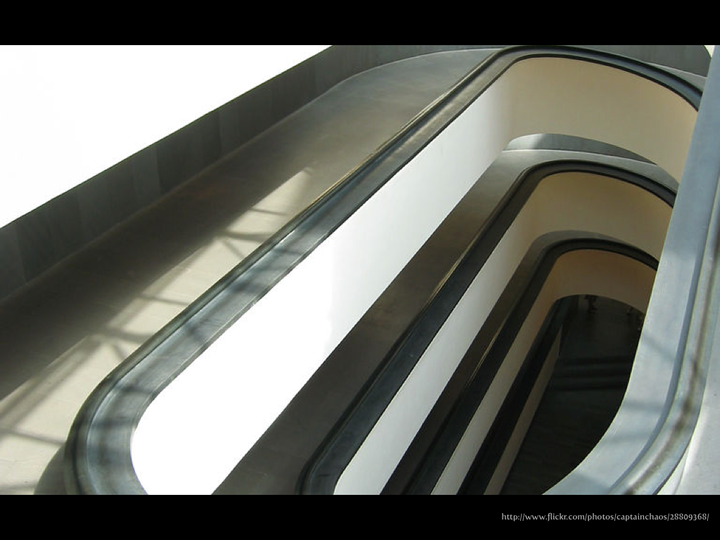
And I'm sure the people walking around the Vatican don't complain about having to use this beautiful ramp either.
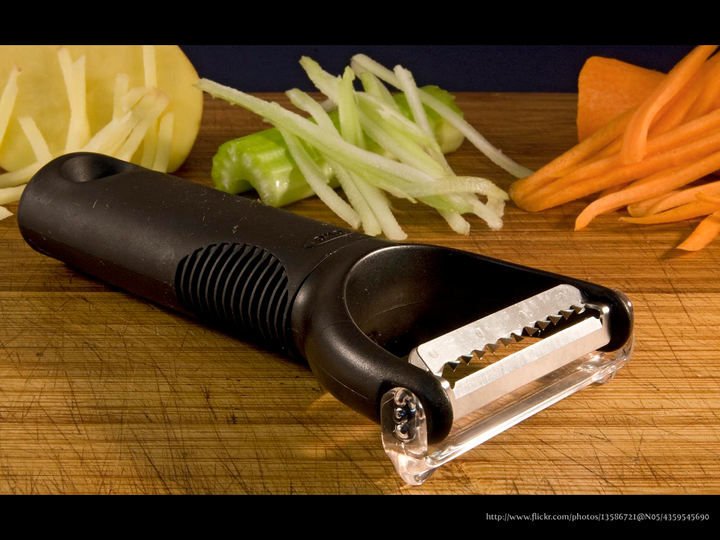
This is the OXO Good Grips Julienne Peeler. I don't know if you've heard of the range or even own any of the items from it. Did you know that they were originally designed for a woman with arthritis? Would it have made a difference to your purchasing decision if you'd known before? Will/would it make a difference now?
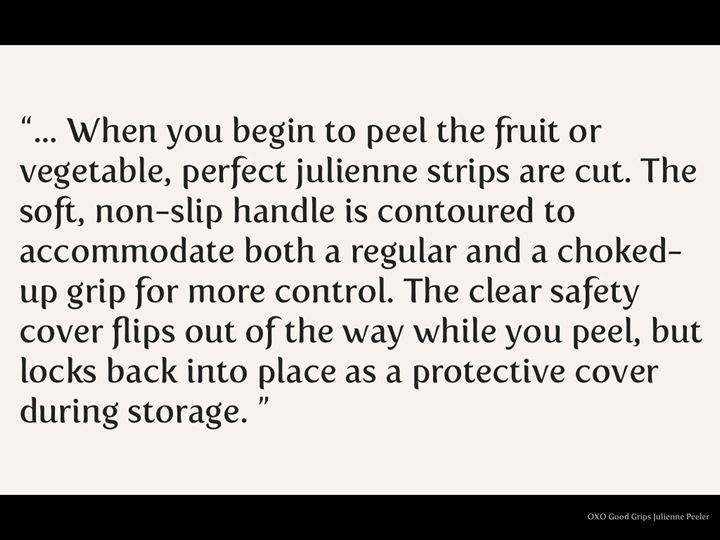
An example of the copy from the OXO Good Grips website about the Julienne Peeler:
"… When you begin to peel the fruit or vegetable, perfect julienne strips are cut. The soft, non-slip handle is contoured to accommodate both a regular and a choked-up grip for more control. The clear safety cover flips out of the way while you peel, but locks back into place as a protective cover during storage."
Do you see any reference to disability in their copy?
Neither did I. They emphasised the ease of use which yes, benefits people with arthritis or other mobility difficulties, but don't limit its usefulness to just that user group. As a result, it's become incredibly successful as a brand, and so it should.
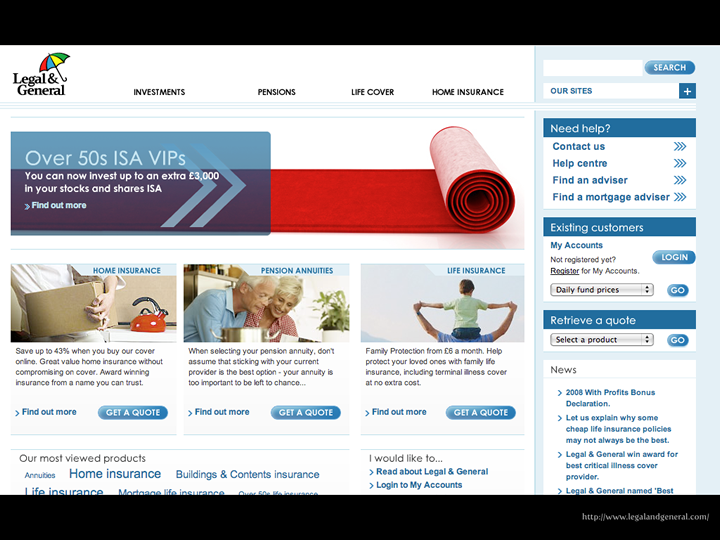
The Legal and General website underwent a redesign which changed the structure to make it easier to find information, and took it a step further and made it easier to understand the information when you did find it. It was an enormous success. Just a few of the staggering statistics that resulted:
- 50% increase in search engine traffic
- immediate 95% increase in requests for quotes
- 90% increase in completed applications
- 300% increase in take up for some products
- conversion rates doubled for the most important revenue generators
- 450% increase in earnings in the five days following the launch of a redesigned product
- longer term 135% increase in completed applications
- return on investment in five months
No, I'm not making it up. More information can be found in Mike Davies’ Presentation to the London Web Standards Group.
It's important to note that these figures were a result of an organic increase in traffic. No additional marketing was done around the time of the relaunch.
The increase in sales as a result of making the site accessible didn’t, for the most part, come from people with disabilities. It came from “normal” people. Making the site easier to use for people with disabilities made it easier to use for everyone, and as a result, more people bought the products.
It's awesome, but I'm incredibly disappointed that we don't have more of these business cases to share.
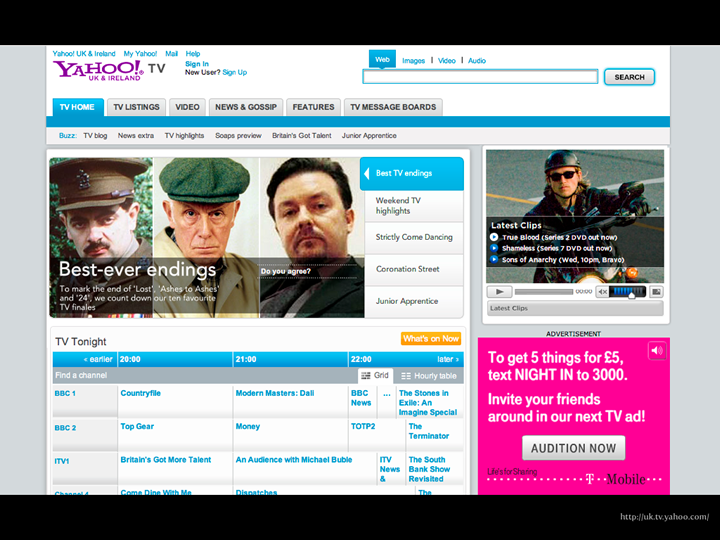
If you start from a good solid base experience and build on it, you can create something pretty special.
The Yahoo UK & Ireland TV section uses a fairly standard design pattern for its faceted search. It looks pretty. It fits with the rest of the design. So what?
So the magic is under the hood.
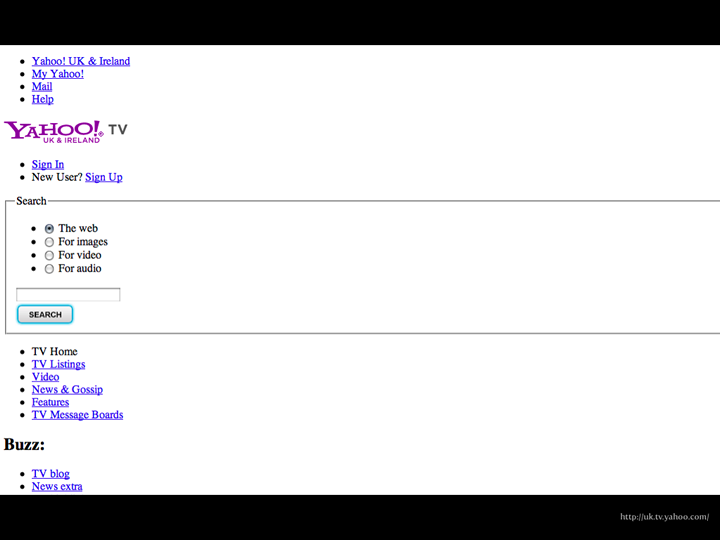
What looked like a standard tabbed search component turns out to be a beautifully designed and built component that uses boring old HTML and CSS to do something rather wonderful, because the developer, Steve Marshall from Yahoo, really thought through the problem and wanted to do something better than what was the current standard approach. I'm amazed this hasn't got more traction by now, since it's more than three years old now.
By using standard form controls and deeply understanding the interaction behaviours that come with those controls, he make something that works beautifully for all users. It's genius.
Which brings me to:
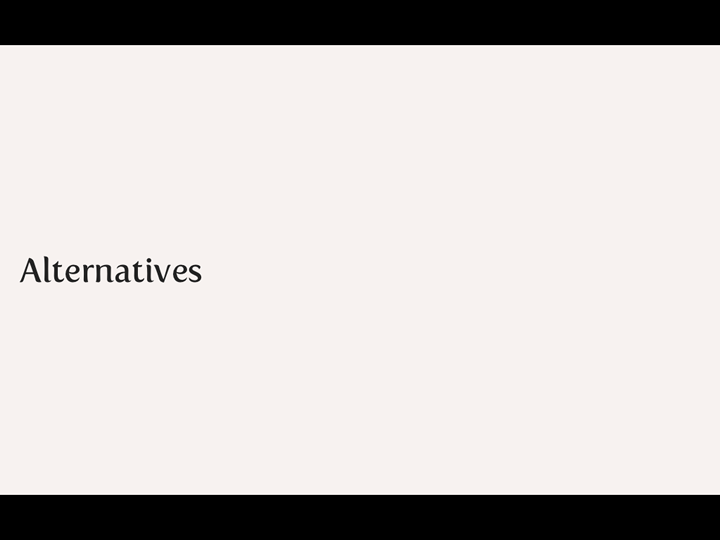
Alternatives
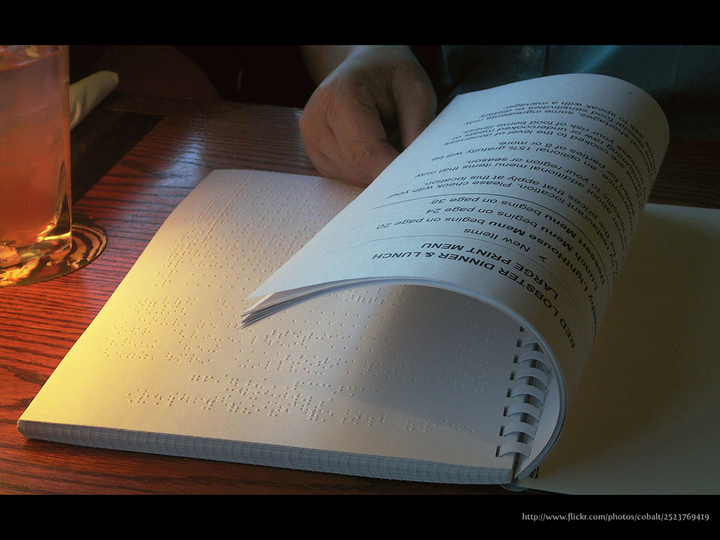
Alternatives don't have to be something hidden. They can be beautiful in their own right. This image shows a restaurant menu that interleaves large print and braille pages and when I found the photo it reminded me of the RNIB Annual Report I saw years ago, which had printed pages interleaved with transparent braille pages. It was able to be read by a broad audience and was a thing of beauty.
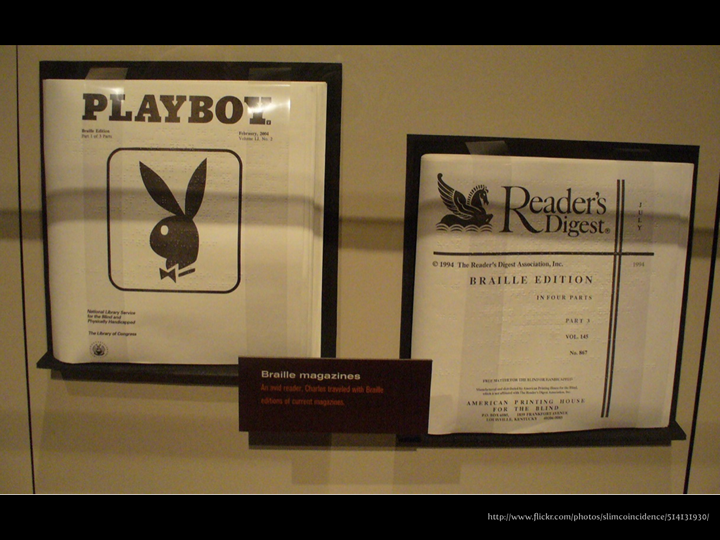
I remember about three months into working at RNIB I had an induction training session and they told us about Braille Playboy. I loved the idea that braille readers could read it "for the articles" too!
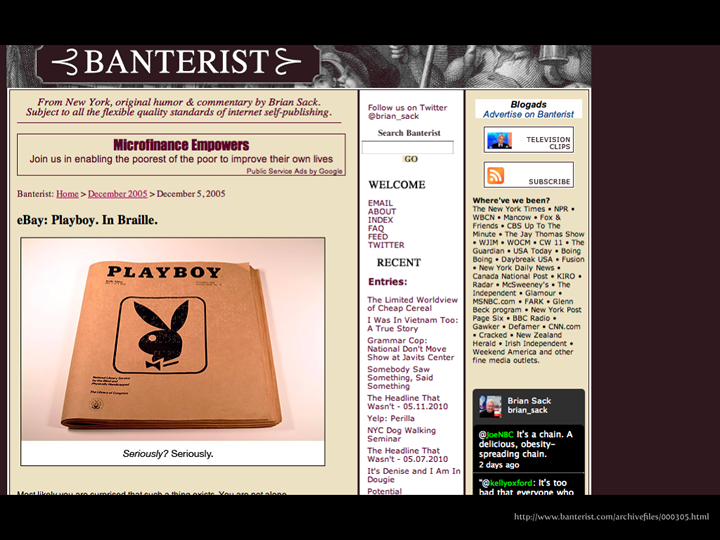
Which leads me to a blog post on Banterist I found when I was searching for images of Braille Playboy and has some of the best captions I've ever seen online. I'm not going to spoil them for you. You'll have to go see for yourself.
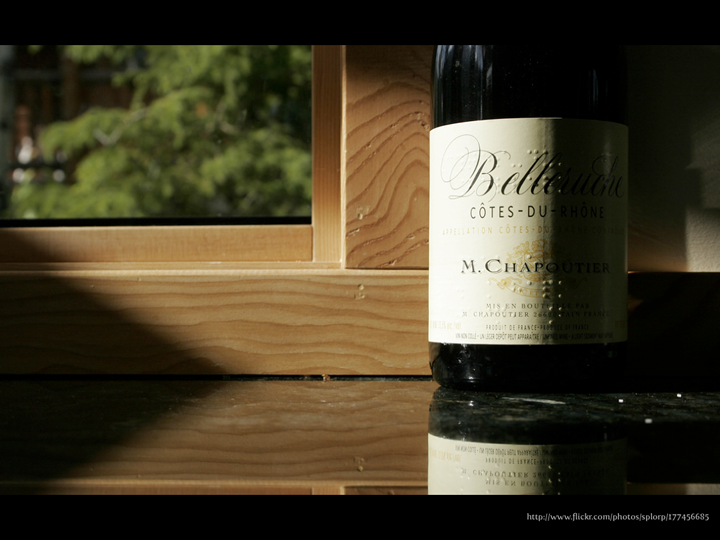
There are Braille/Print Hybrid Labels. I really don't think the presence of braille on this label harms the aesthetics or the information. Do you?
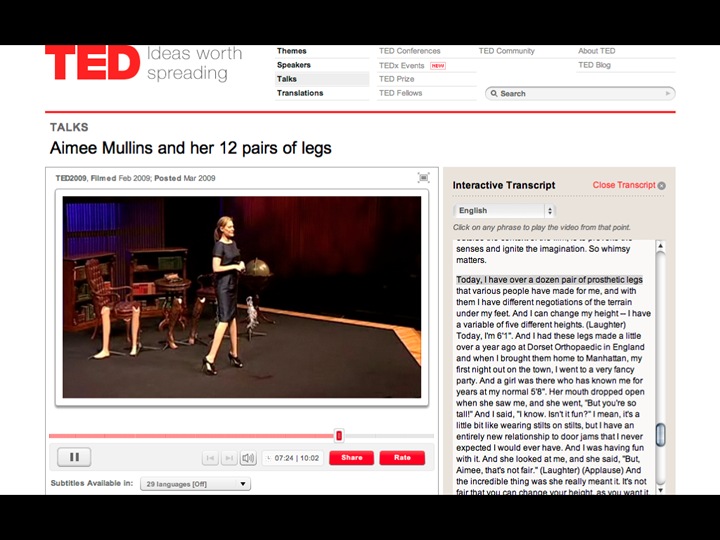
TED.com displays interactive transcripts adjacent to the videos. You can click on the text and it will skip you to the right place in the video. Doesn't get in the way of the experience for someone who doesn't have problems with sound, and actually comes in really handy when you want to skip to a particular place.
Transcripts are one of the few alternatives that are genuinely time consuming to provide, but it doesn't always HAVE to be the content provider doing the transcribing.
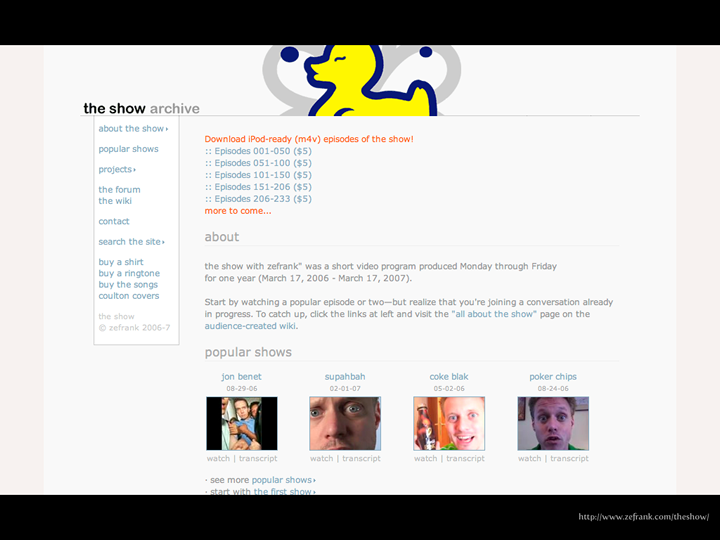
Ze Frank's The Show was the first instance I can ever remember of seeing crowd-sourced transcripts. In his case it wasn't so an audience of disabled people could access them, it was so people who were behind firewalls or couldn't otherwise get at the videos could read the transcripts and so members of the community which developed around the videos raced to help transcribe. Fabulous.
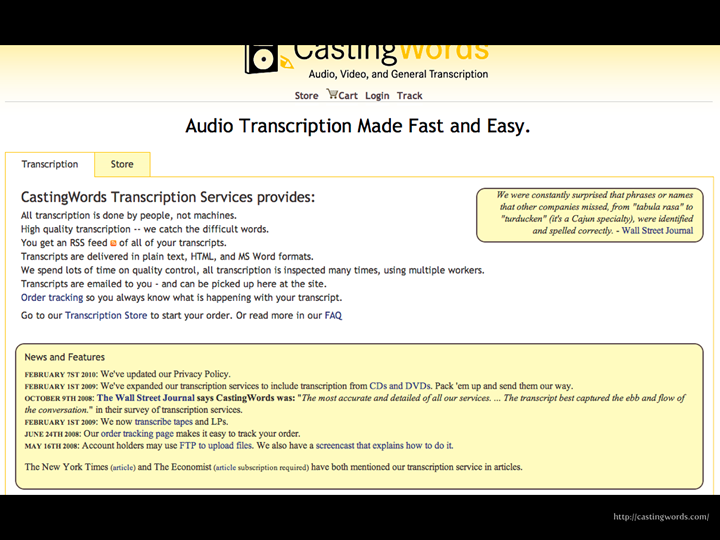
Of course, not everyone has the popularity of Ze Frank, so there are services available online, like Casting Words, where for a few dollars you can get a transcript done for you. It's easy and usually fast, though not necessarily 100% accurate, but it'll get you a lot of the way there.
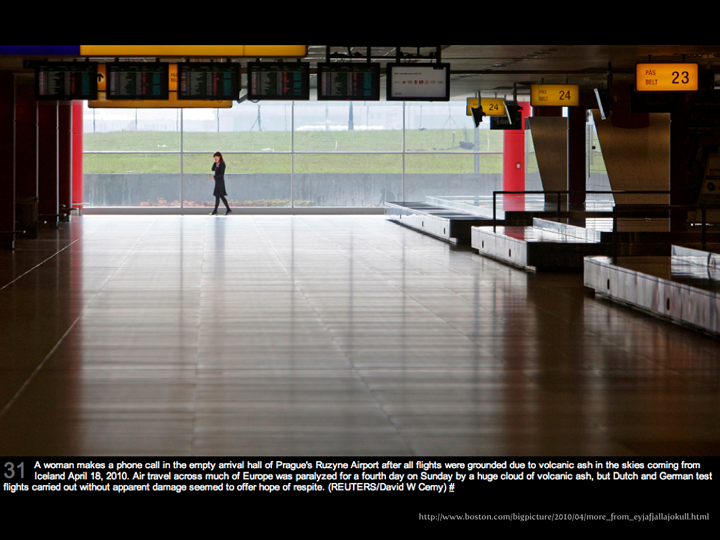
My favourite example of descriptive captions as page content is Boston.com's Big Picture. The alternative adds something for those who can see both, rather than detracting from the image.
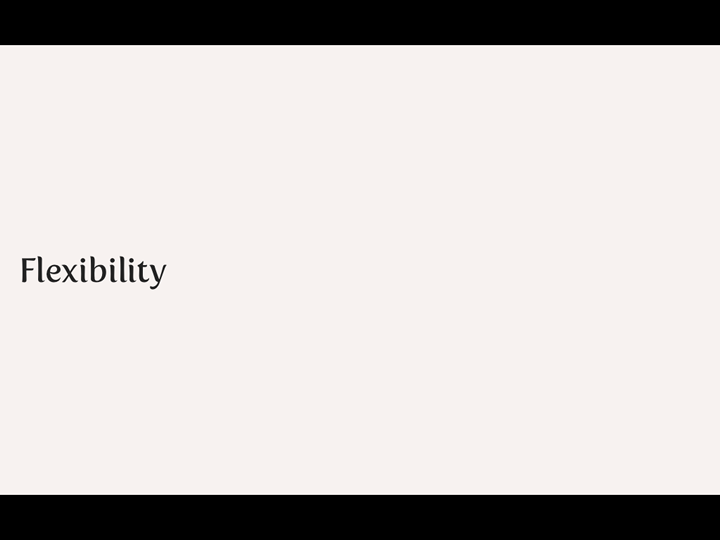
Flexibility
Everyone's different. Uses a different machine. Sits in different light. Has varying degrees of hangover/tiredness when they get up each morning.
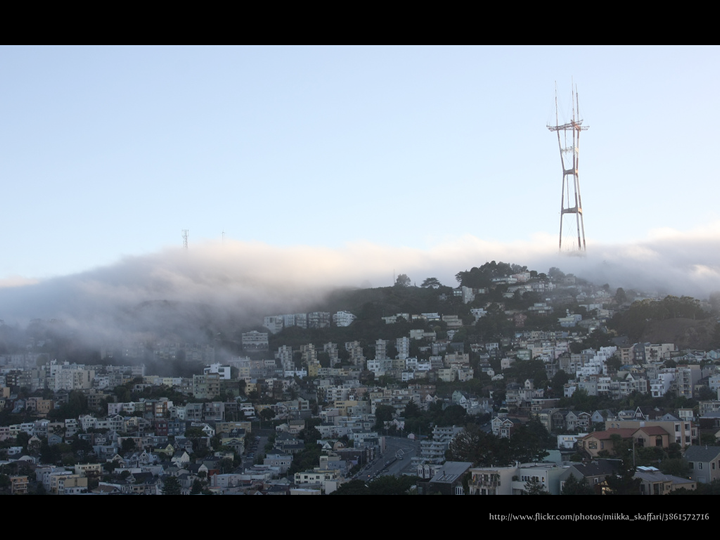
People aren't static. Some people have conditions which can change throughout the day. They may be fine in the morning, but come mid-afternoon and they can feel a "fog" rolling in which might affect their ability to see the screen or think clearly. They may have to increase the text size or use other assistive technology.
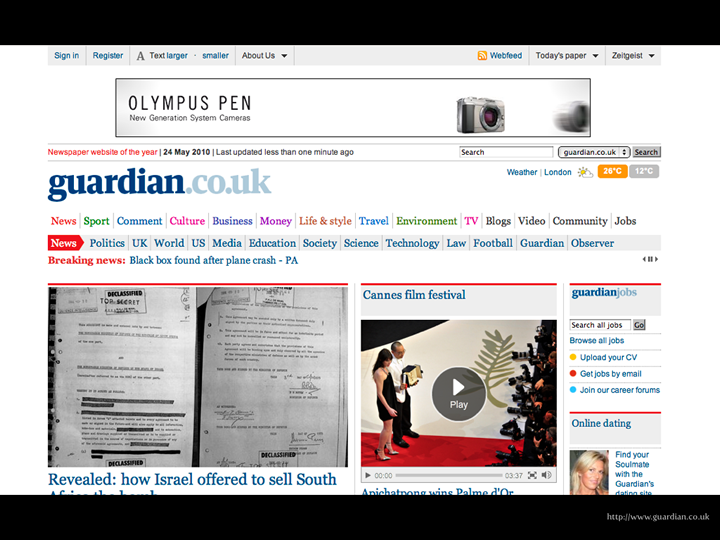
The Guardian Newspaper website provides a handy text resize widget on their site.
Now yes, text resize widgets are controversial in that they only help the user on that particular site, but if the user doesn't know how to change their browser settings, surely a text resize widget on each website is better than nothing?
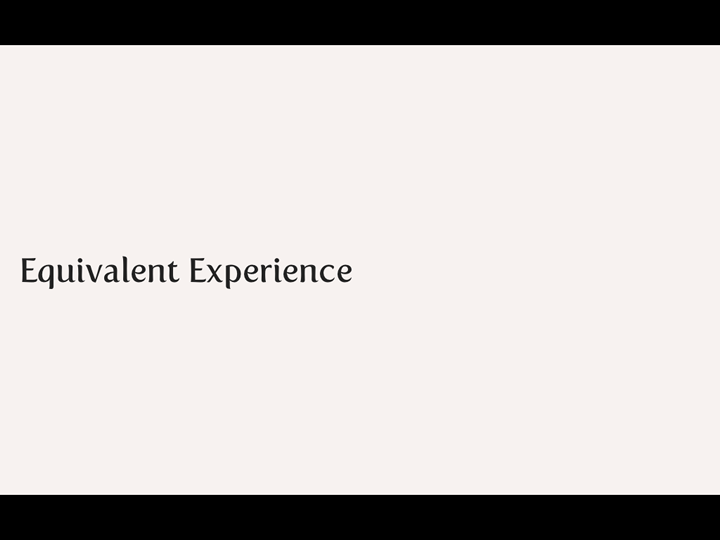
Equivalent Experience
Note that I explicitly don't mean the SAME experience.
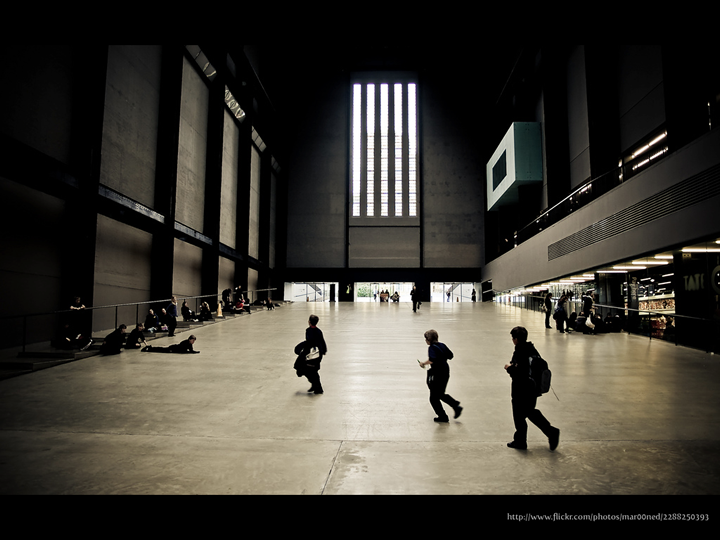
I used to think that Tate Modern was a pointless waste of time, then I watched a programme featuring a colleague. He explained why it was his favourite gallery and led a tour of some of his favourite works. Nothing extraordinary, right? Except he is registered blind and has very little useful vision. His experience wasn't and isn't the same as those who view the artworks with their eyes, but that doesn't make it less of an experience. It made me feel a little ashamed that I hadn't given the works the attention they deserve and that I'd been so narrow minded about the ways that people can experience art.
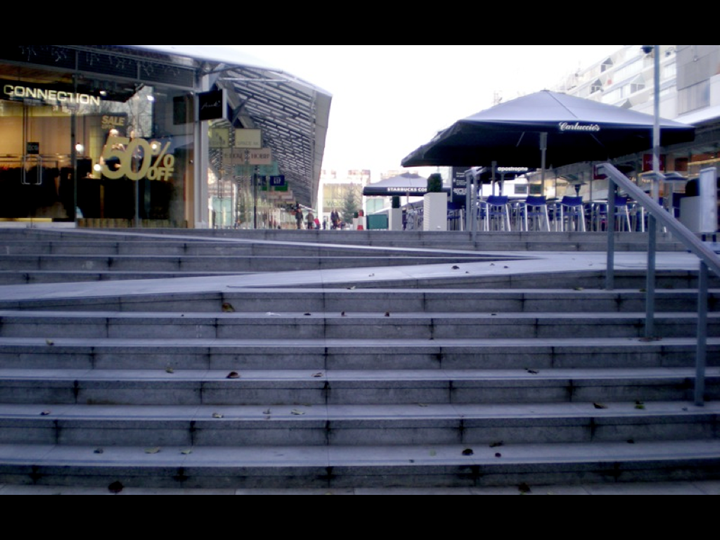
I worked near the Brunswick Shopping Centre at Russell Square in London for several years, and during that time it was renovated from, frankly, a shit-tip into a swanky upmarket shopping centre. When it renovated, there were a number of nice features included by the architects, including one I didn't even notice until I was doing some internet research for a previous talk on making accessibility sexy.
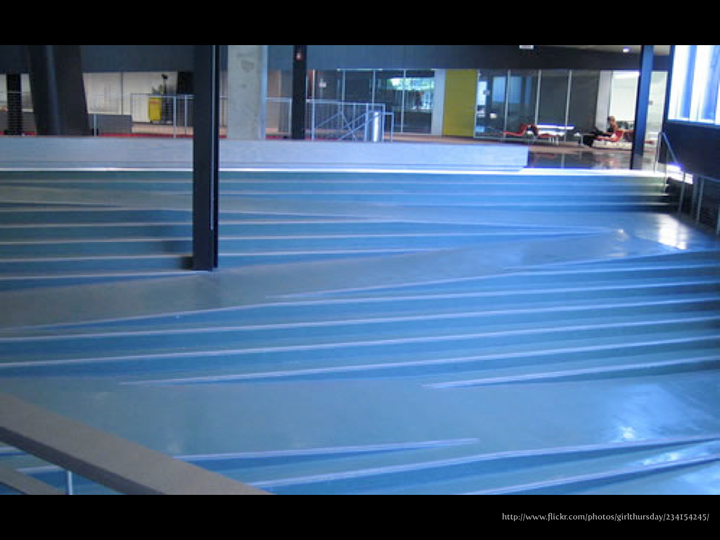
I found a picture of some steps with an integrated ramp and thought it was a genius idea, grabbed the photo, used it in my presentation and didn't think any more of it.
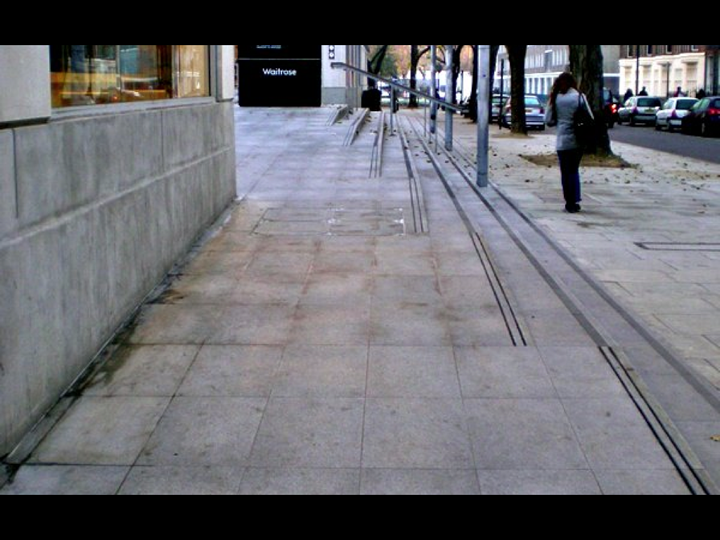
Until a couple of days later when I went back to the Brunswick Shopping Centre and suddenly it struck me.
I'd been using those stairs all along and hadn't noticed.
For MONTHS.
They just worked. For everyone. No signposted and segregated wheelchair ramp. Just something beautifully simple that everyone could use.
Sure, the experience of going down a ramp in a wheelchair is different to that of walking down with (or without) a pushchair is different to walking down steps, but the thing is that each experience is good. They're equivalent.
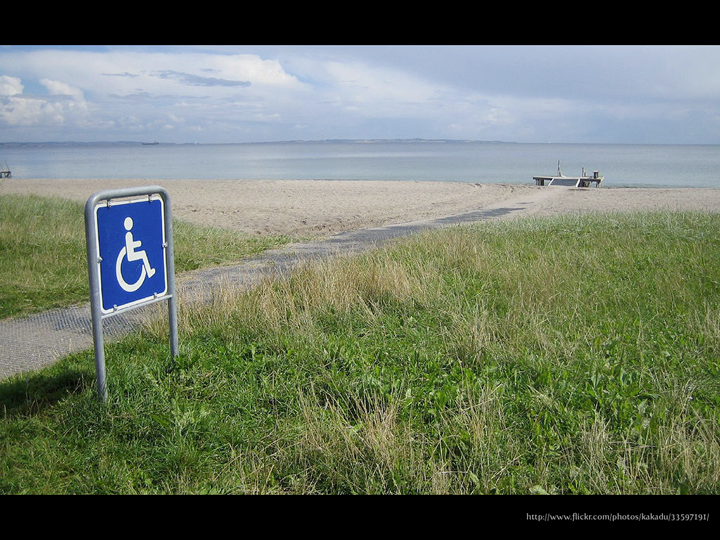
It can be tough to think of how to provide an equivalent experience in some cases, but a bit of creative thinking can result in an neat solution, like plastic mesh matting that allows a wheelchair user to get access to the beach and the sea, just like everyone else.
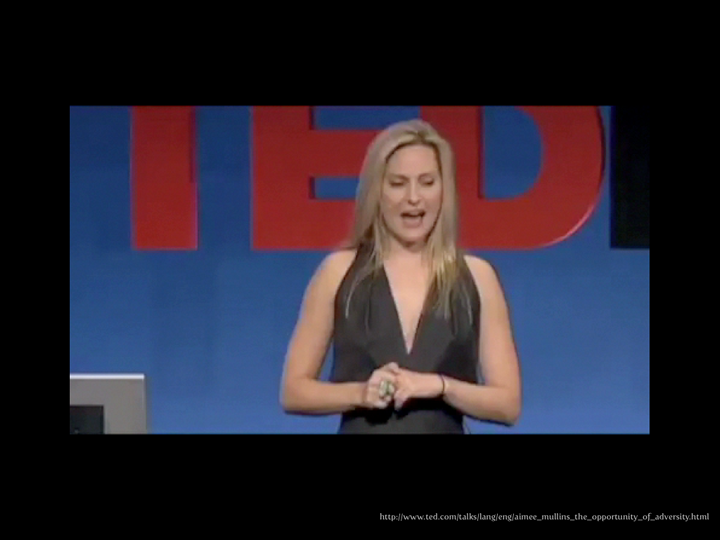
Here's Aimee Mullins again. The bit I showed in the talk starts at 4.39 and stops 6.09. You can read the transcript of that bit below the video.
I had to do what seemed like innumerable repetitions of exercises with these thick, elastic bands -- different colors -- you know, to help build up my leg muscles. And I hated these bands more than anything. I hated them, had names for them. I hated them. And, you know, I was already bargaining, as a five year-old child, with Dr. P to try to get out of doing these exercises, unsuccessfully, of course. And, one day, he came in to my session -- exhaustive and unforgiving, these sessions -- and he said to me, "Wow. Aimee, you are such a strong, powerful little girl, I think you're going to break one of those bands. When you do break it, I'm going to give you a hundred bucks."
Now, of course, this was a simple ploy on Dr. P's part to get me to do the exercises I didn't want to do before the prospect of being the richest five year-old in the second floor ward, but what he effectively did for me was reshape an awful daily occurrence into a new and promising experience for me. And I have to wonder today, to what extent his vision, and his declaration of me as a strong and powerful little girl, shaped my own view of myself as an inherently strong, powerful and athletic person well into the future.
Changing the experience can change someone's life. You could make it possible for someone to do something, by themselves and without any help, for the first time in their lives. Travel. Online banking. Shopping. Finding a partner. Whatever.
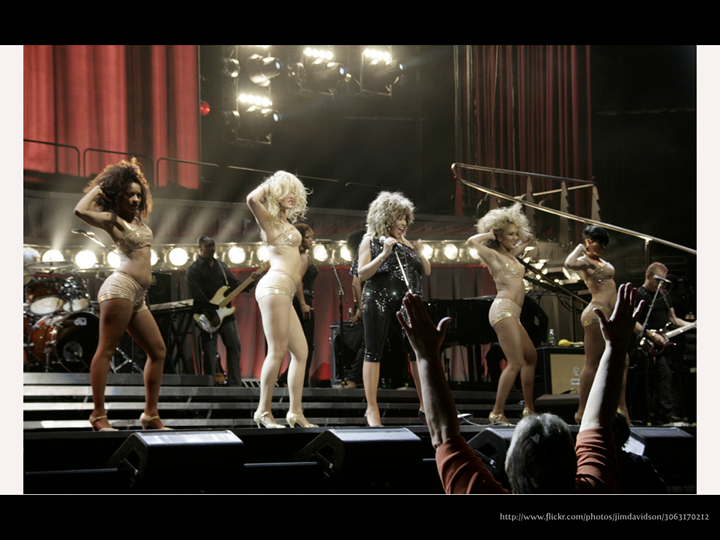
RNIB ran a series of awards called "Simply The Best" a few years ago, and one year, they decided to have a best website category because surely, any website voted the best by blind and partially sighted people would be accessible, right? Wrong. The most voted for websites were Amazon and Play.com, neither of whom were (either at the time or right now) in anyone's top 10 for accessibility. What they did have, however, was a compelling reason to use the site and as a result, people developed coping strategies. One colleague I talked to would have to spend, he estimated, around 24 hours of time figuring out what had changed every time Amazon changed their site.
That's outrageous. Don't get me wrong, it's testament to how a compelling offering will motivate users, but it just shouldn't be so difficult to spend money online.
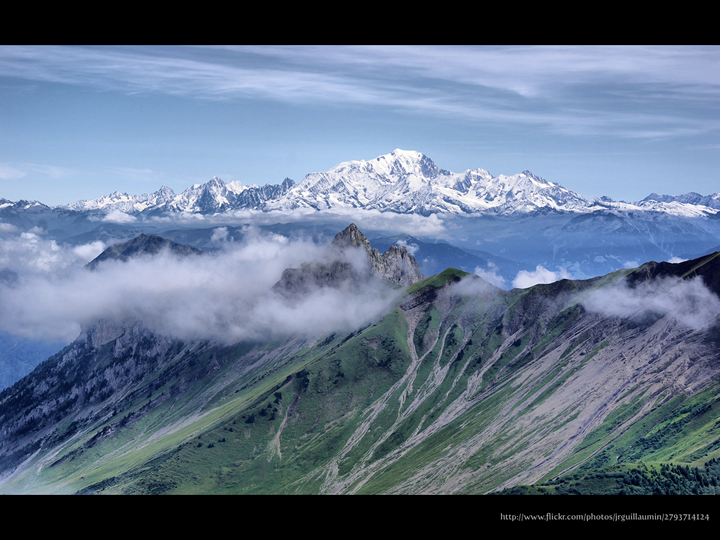
I know some of this stuff is hard, but if it was easy, we, as designers and developers wouldn't find it nearly so satisfying to solve the problems. It's what motivates me to keep going, and is what motivated me to go and work on designing software for Investment Banks, one of the most challenging office-based work environments I can imagine.
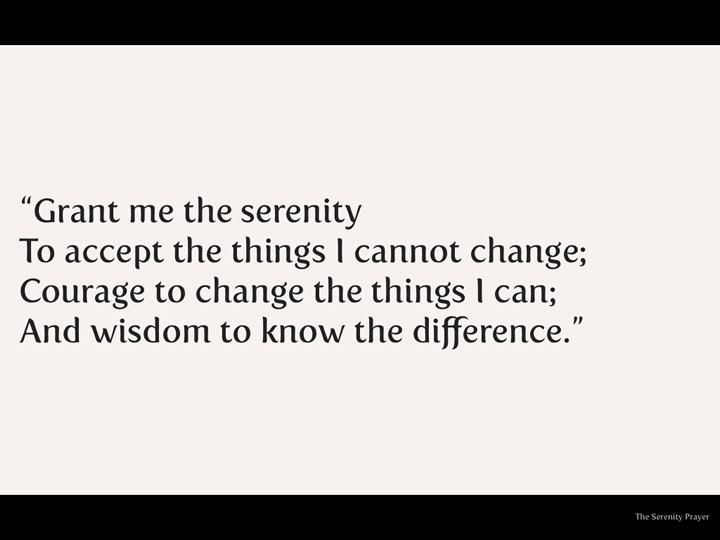
The Serenity Prayer (often used by Alcoholics Anonymous says:
Grant me the serenity To accept the things I cannot change; Courage to change the things I can; And wisdom to know the difference.
It's not easy, and we won't always solve the problems first time we try, but if we change the things we can and keep working on the things we can't change right now, we can change the world.
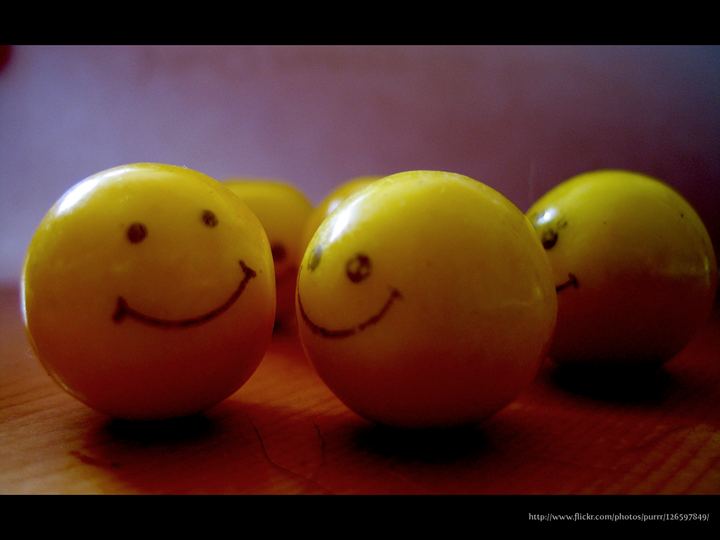
At the end of the day, we're empathic people - if what we does makes people happy, then we're happy.
So don't worry about accessibility.
Do what you do, to the best of your ability (and ask for help if you think you're out of your depth) and Be Happy.
Thank you.
The UX Practitioner’s Prayer
Grant us the… Serenity to accept the things we cannot change, Courage to change the things we can, and the Wisdom to know the difference Patience for the things that take time Appreciation for all that we have achieved, and Tolerance for those with different viewpoints Freedom to live beyond the limitations of our past [...]
Read More

